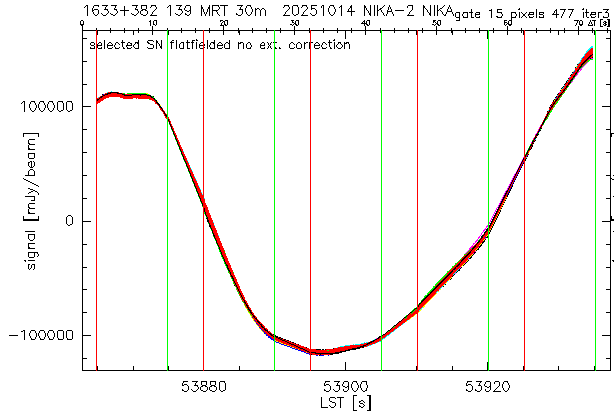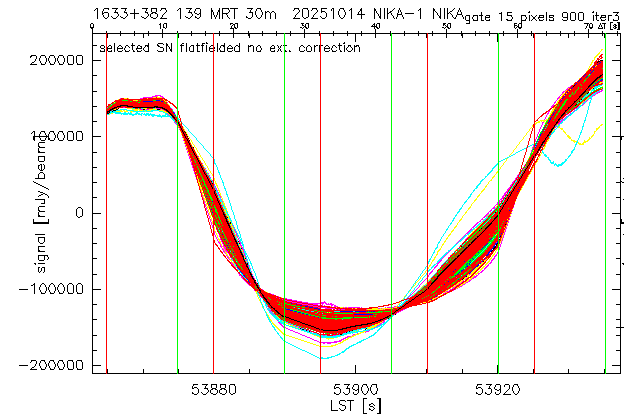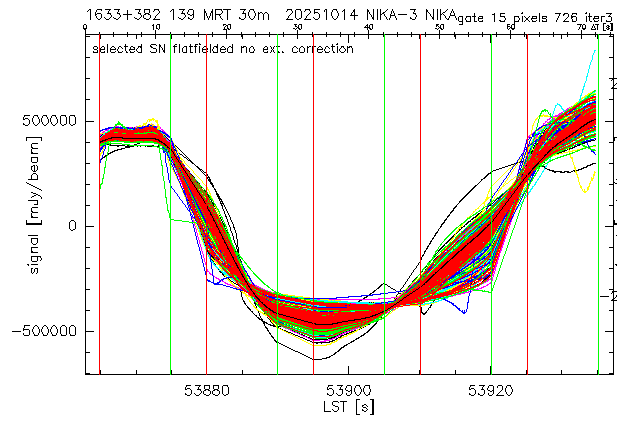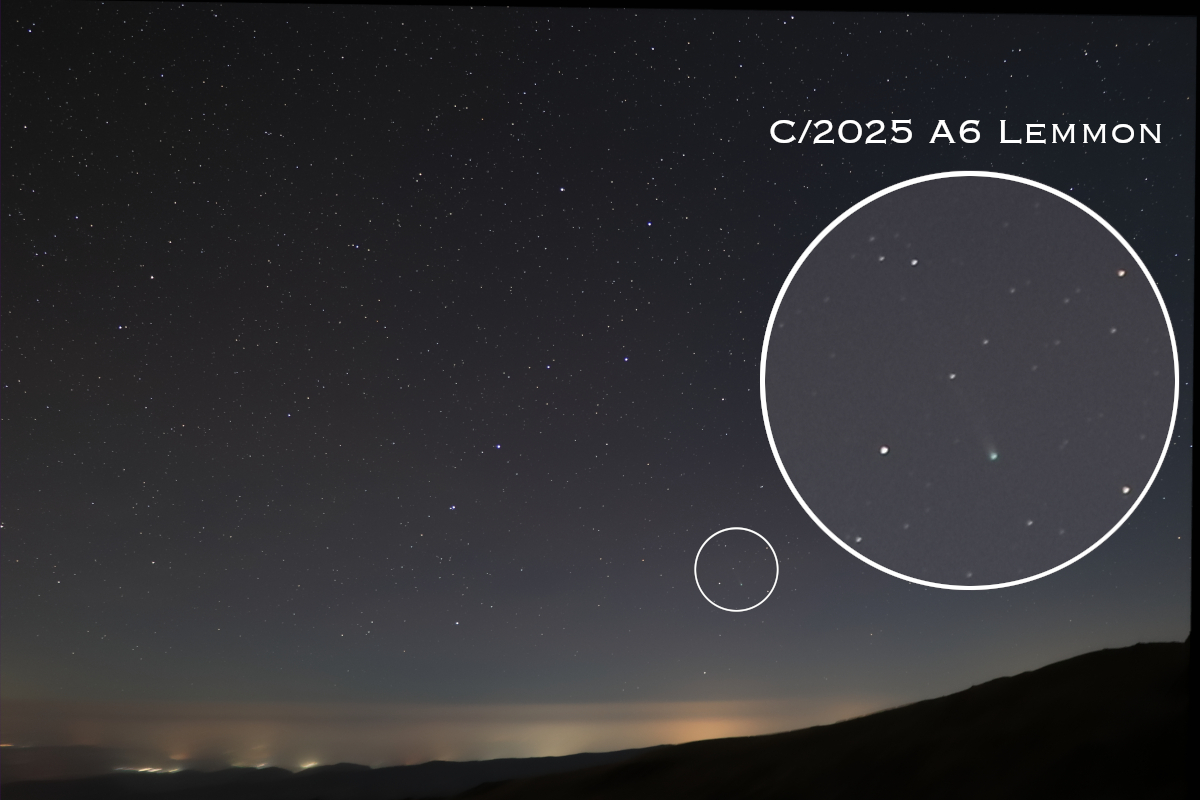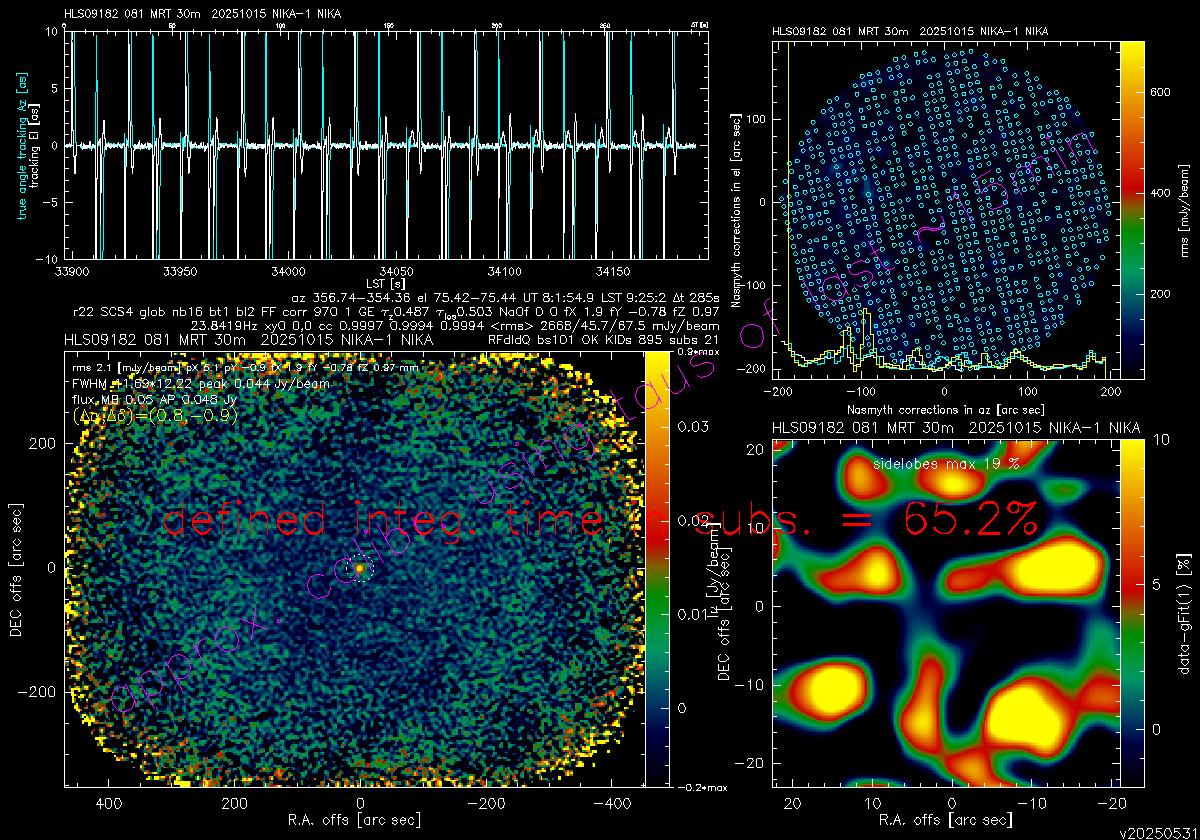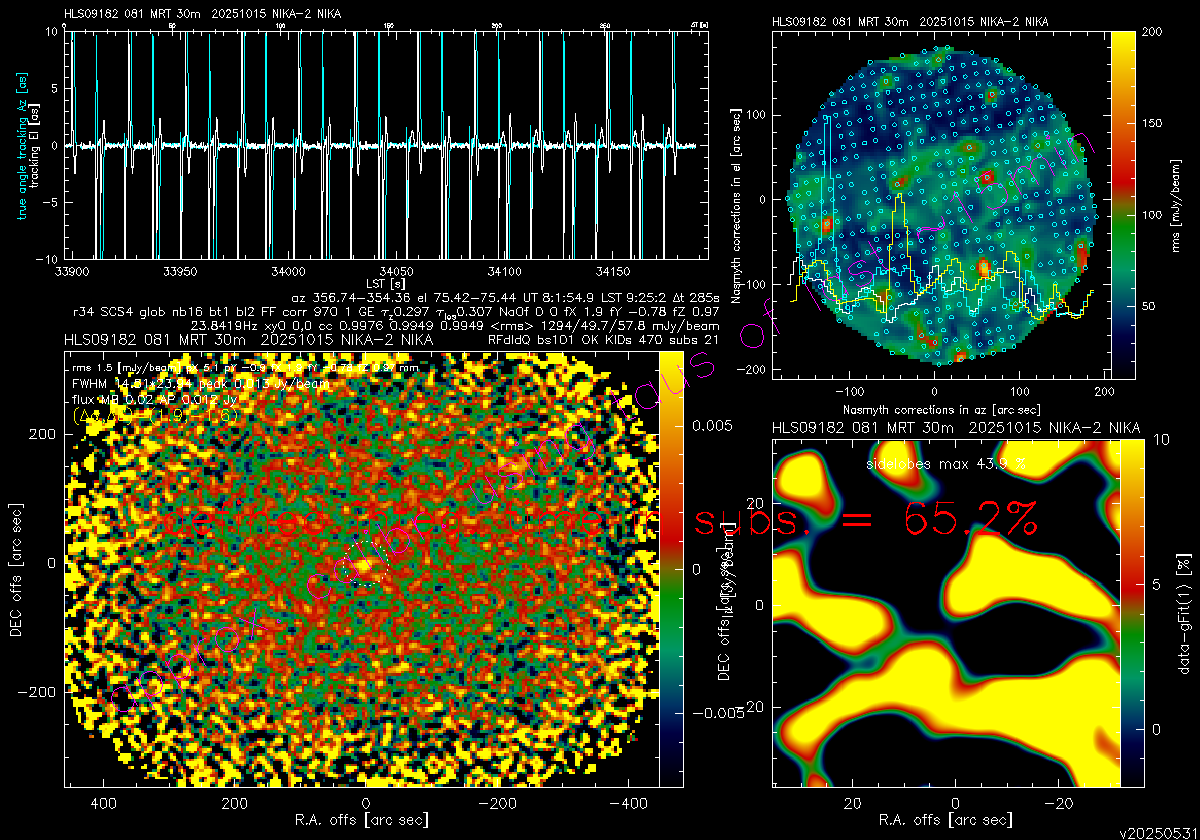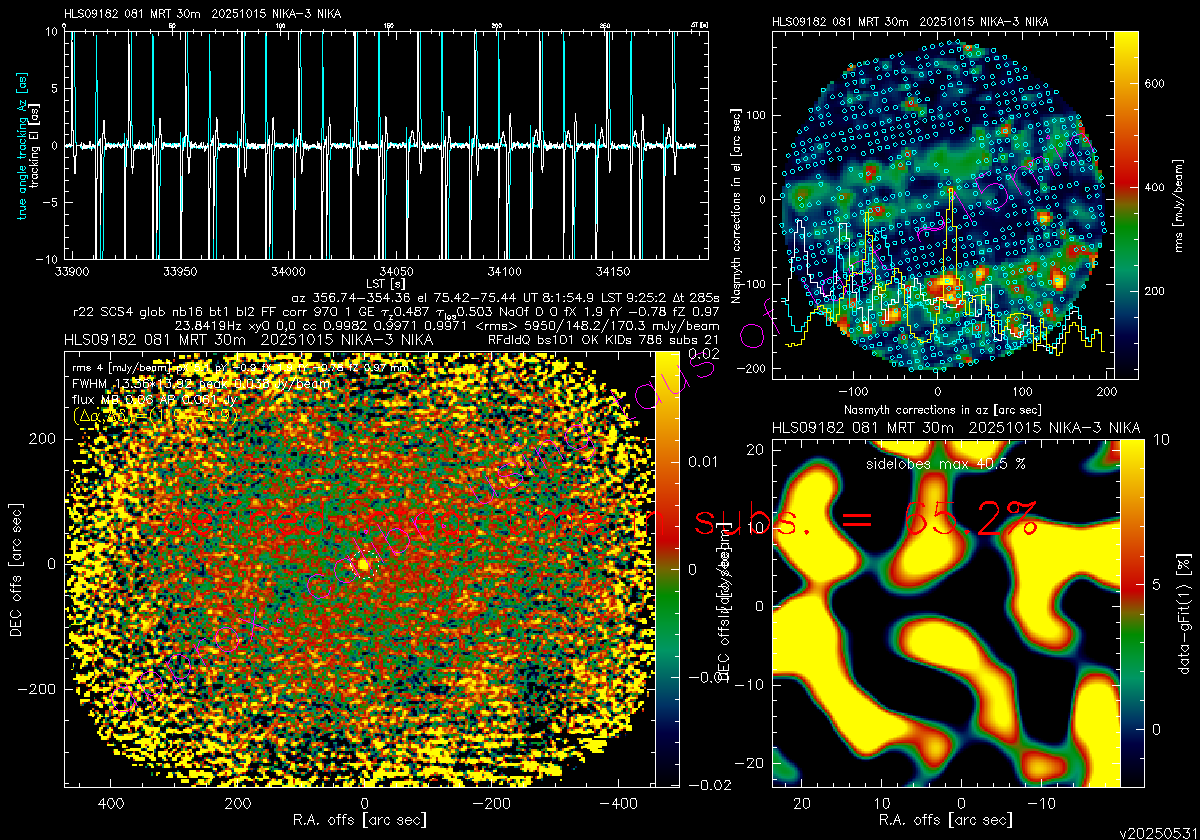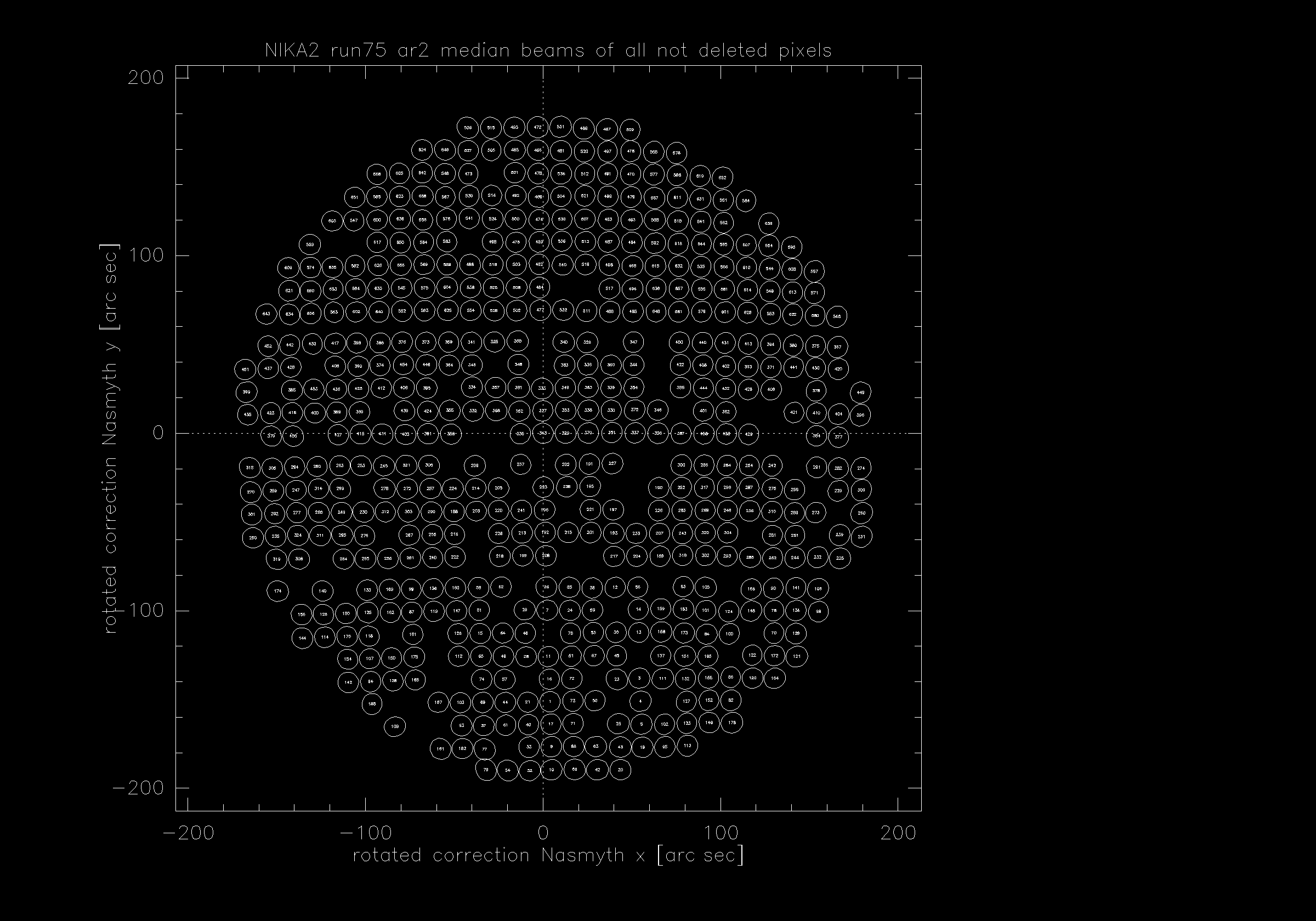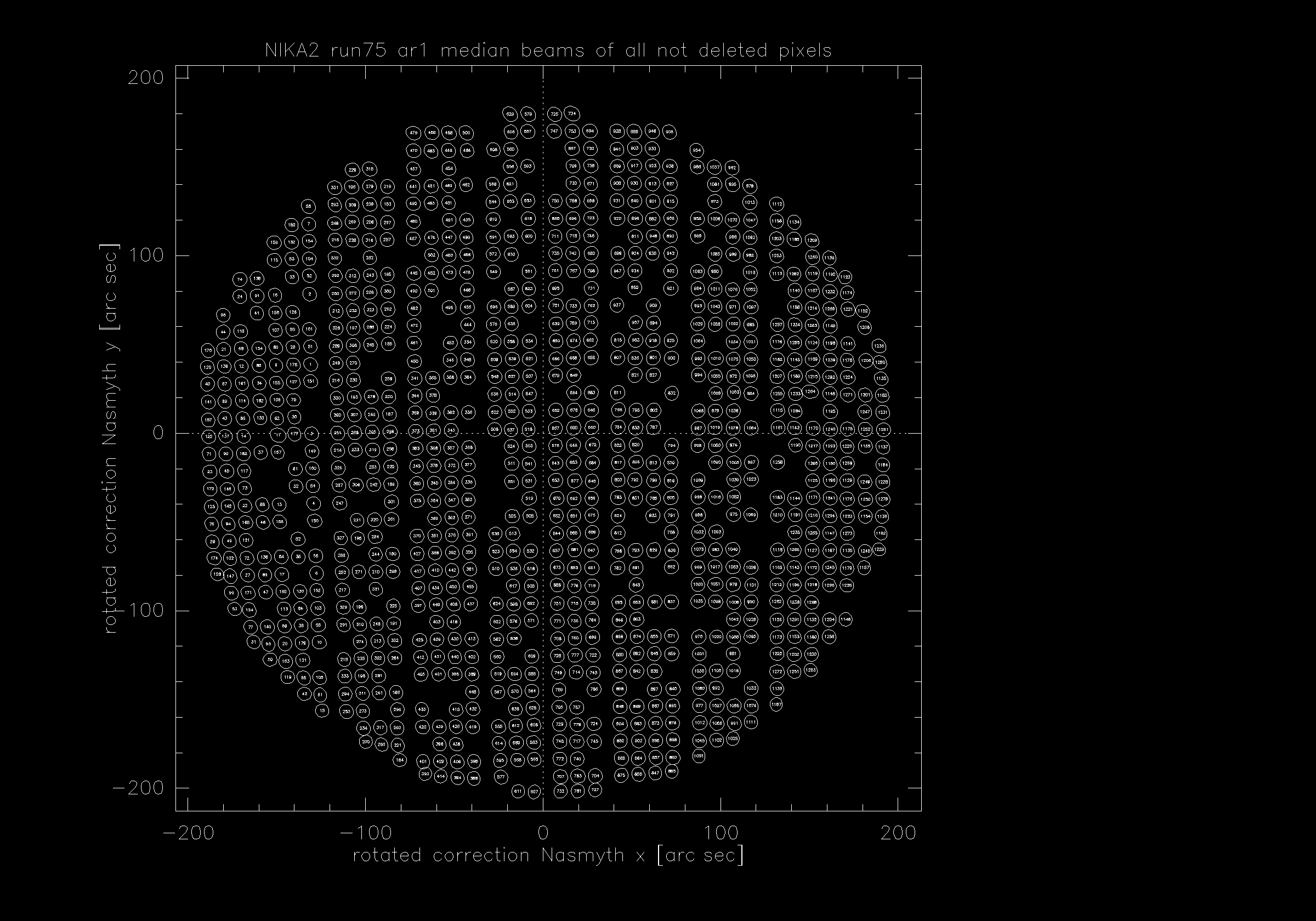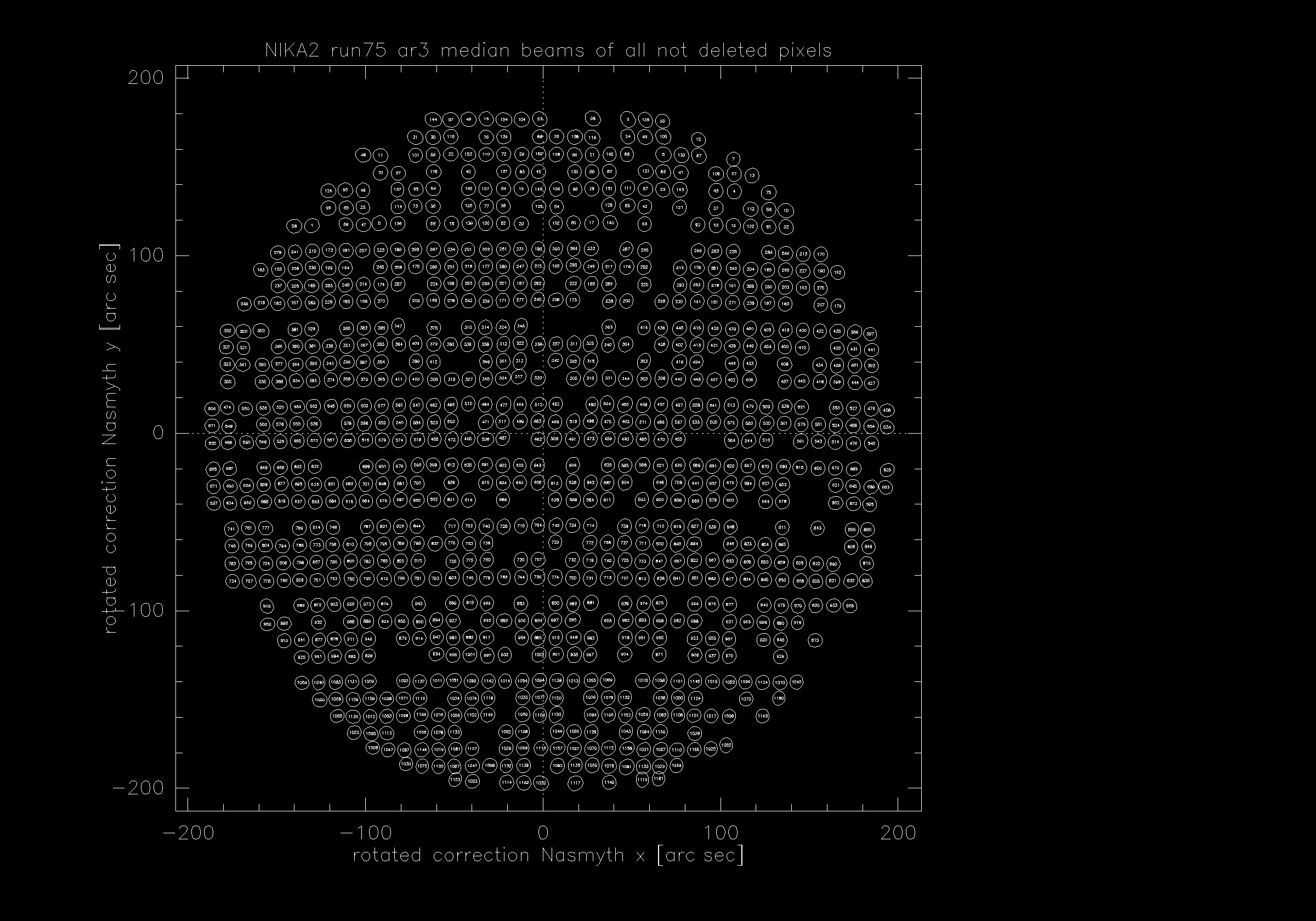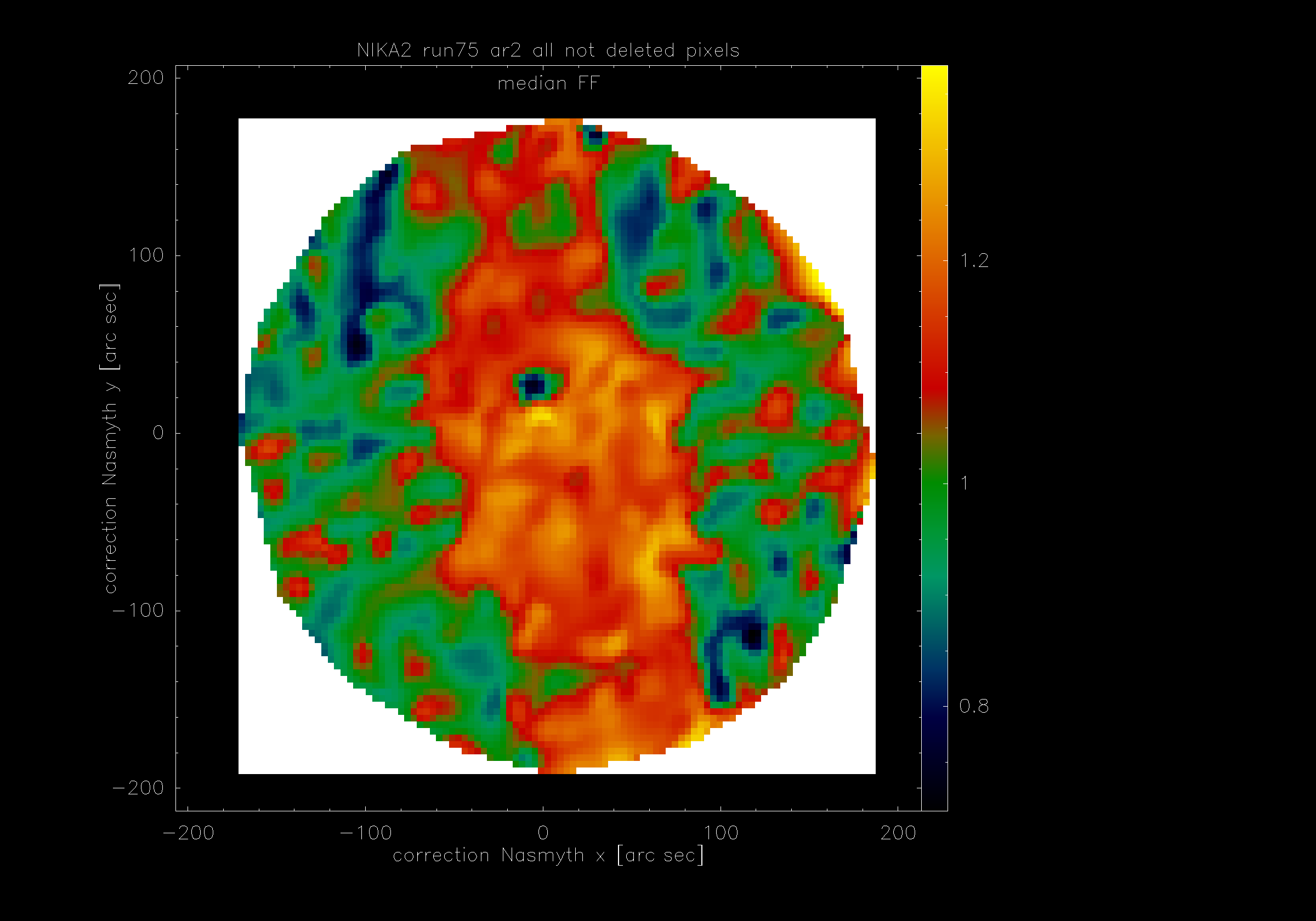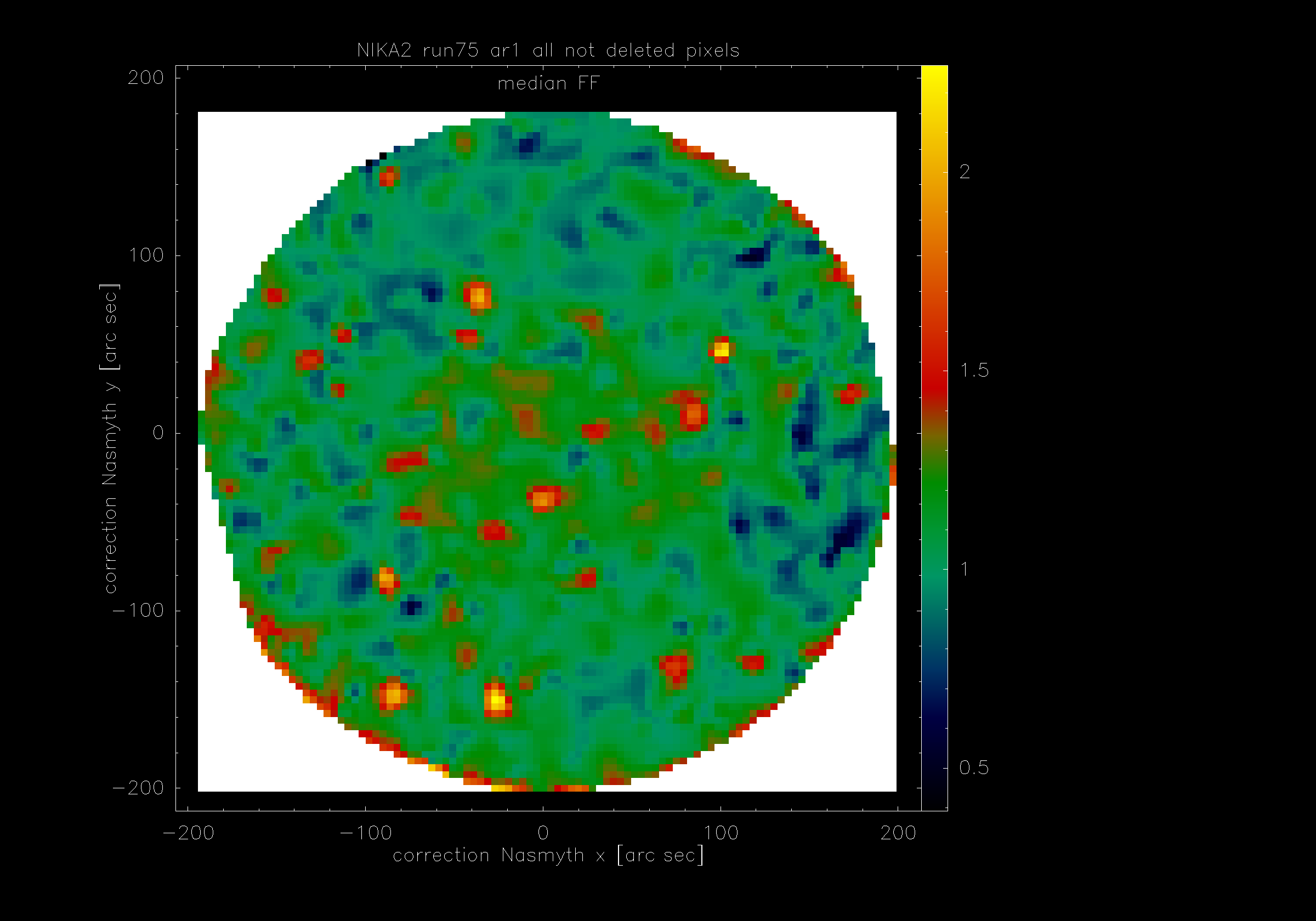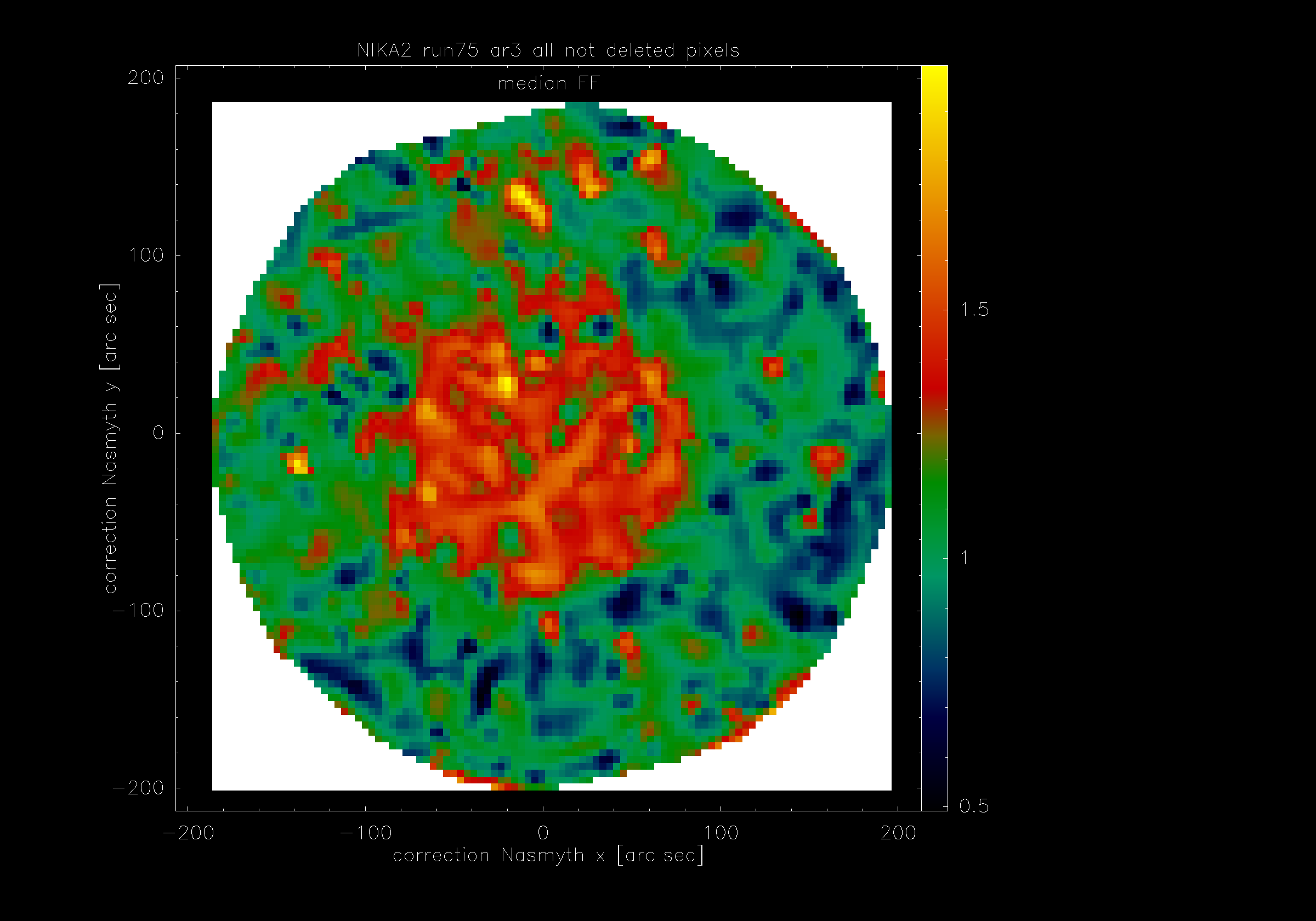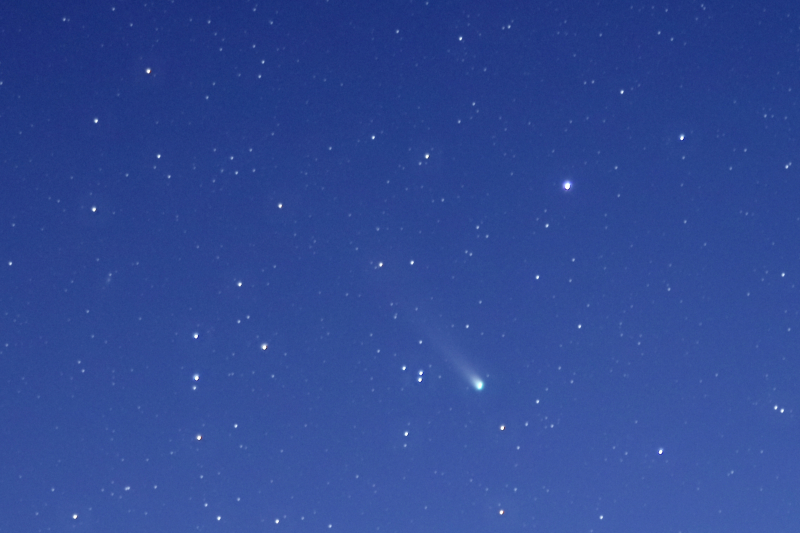|
Size: 6220
Comment:
|
Size: 40614
Comment:
|
| Deletions are marked like this. | Additions are marked like this. |
| Line 14: | Line 14: |
Angel, Miguel, Stefano, and maaaany others arrive at the telescope. |
|
| Line 23: | Line 25: |
| @15:00 LT we start, after preparing the whole "NIKA2 week environment architecture: 15/8/55 lost KIDs in Ar 1,2,3. Unstable sky and thick clouds coming from the N. We're entering in the peak of the tau forecast. It will be better later this evening. Meanwhile we try to focus. The old make-imbf script does not produce the imbfits files. Angel contacts Albrecht to solve the issue. The new make-imbf produces the file regularly. | @15:00 LT (13:00 UT) we start, after preparing the whole "NIKA2 week environment architecture: 15/8/55 lost KIDs in Ar 1,2,3. Unstable sky and thick clouds coming from the N. We're entering in the peak of the tau forecast. It will be better later this evening. Meanwhile we try to focus. The old make-imbf script does not produce the imbfits files. Angel contacts Albrecht to solve the issue. The new make-imbf produces the file regularly. |
| Line 26: | Line 28: |
| Line 28: | Line 31: |
| [[attachment:20251014s139_ar3.png|{{attachment:20251014s139_ar3.png|Ar3 bad sky|height=250}}|target="_blank"]] | [[attachment:20251014s139_ar3.png|{{attachment:20251014s139_ar3.png|Ar3 bad sky|height=250}}|target="_blank"]] <<BR>> |
| Line 33: | Line 37: |
| We work on the focus. Here follow our observations/notes. It is hard to get the focus value for all three arrays at once. The Ar2 flux criterion shows big jumps. The Ar2 FWHM and flux criteria do not agree. It almost seems like the flux is maximized not when the FWHM is minimized. Strange behavious, almost as if there were more than one "best" focus position. We enlarge the focus range of the 5 scans sequence. It was +/- 0.8 mm in steps of 0.4 mm. Now we changed it to +/- 1.0 mm, in steps of 0.5mm. The aim is to see if we can have a more complete sampling of the focus curve (for all criteria). The new script is called focusOTF-Z_2025.pako. We also try with a total excursion of +/-1.2 mm and steps of 0.6 mm. It seems that this latter solution is the best. | We work on the focus. Here follow our observations/notes. It is hard to get the focus value for all three arrays at once. The Ar2 flux criterion shows big jumps. The Ar2 FWHM and flux criteria do not agree. It almost seems like the flux is maximized not when the FWHM is minimized. Strange behaviour, almost as if there were more than one "best" focus position. We enlarge the focus range of the 5 scans sequence. It was +/- 0.8 mm in steps of 0.4 mm. Now we changed it to +/- 1.0 mm, in steps of 0.5mm. The aim is to see if we can have a more complete sampling of the focus curve (for all criteria). The new script is called focusOTF-Z_2025.pako. We also try with a total excursion of +/-1.2 mm and steps of 0.6 mm. It seems that this latter solution is the best. |
| Line 36: | Line 40: |
We alternate pointing/focus obtained with the old sweep and beam maps taken with the new one. The goal is to have at least two beam maps per array, taken with the optimal focus for that same given array. In the tables below, we list: focus sequences, beam maps, calib_1scan, other relevant scans, and a book keeping of sweep changes (to be used when defining the new calibration files - PIIC DAFs, for example - for this recommissioning run). === End of the day+night summary === At the end of the day+night, we have: * 3 beam-maps on best focus for each array; * one de-focused beam map at the Ar2 focus minus 0.3 mm and one at plus 0.3 mm; * one de-focused beam map at the Ar3 focus plus 0.3 mm. In this way, we cover the whole range from Ar2-0.3 to Ar3+0.3 with 6 focus positions: Ar2-0.3, Ar2, Ar2+0.3, Ar1, Ar3, Ar3+0.3. It might turn out that we need more positions in order to determine well the three focal surfaces. Note that the latter 2 items (in the list above) have been performed when the taumeter opacity started to increase. Nevertheless the l.o.s. peak-to-peak sky noise variations kept being ~1 Jy/beam the whole time. If these last three beam maps have issues, we'll need to perform a whole sequence of 6-7 beam-maps at different focal positions, during a ''very stable'' night, such that the reference focus does not vary across the sequence (it takes few hours, hence the ''very stable'' need.) '''''Note also that the best way to carry out a beam maps focus sequence qould be to observe them one after the other on the same target, during a very stable night, such that the "reference" focus would not change along the whole sequence. If we'll get a very stable night, we shall do it!''''' Impressions about the difference in focus of the three arrays. The focus difference between Ar2 and Ar1 seems to be between 0.6 and 0.7 mm. The focus difference between Ar1 and Ar3 seems to be further 0.2-0.3 mm. The total focus difference between Ar2 and Ar3 reaches up to 1.0 mm. A decent compromise might be to use the focus of Ar1 as reference, but a quantitative analysis is needed to say the last word. === Tables (from 2025/10/14 ~13:00 UT to 2025/10/15 ~4:00 UT) === |
|
| Line 39: | Line 62: |
| || 20251013s161-165 || 2251+158 || -0.3 || +0.3 || ... || start at +0.2 mm; Big jumps in FWHM and flux during the focus sequence in Ar2 || | || 20251014s161-165 || 2251+158 || -0.3 || +0.3 || ... || start at +0.2 mm; Big jumps in FWHM and flux during the focus sequence in Ar2 || |
| Line 41: | Line 64: |
| || 172-176 || 2251+158 || -0.05 || +1.0 || ~+1.2 || start at +0.7; custom script with 0.5 mm step instead of 0.4 mm; is the difference between Ar2 and Ar1 become larger? || || 177-181 || 2251+158 || +0.13 || +0.75 || +1.0 || start at +0.7; custom script with 0.6 mm step instead of 0.4 mm; this is the best so far; || || 185-189 || 2251+158 || +0.37 || +1.21 || ... || start at +0.7; custom script with 0.6 mm step instead of 0.4 mm || || 191-195 || 2251+158 || +0.34 || +1.12 || +1.42 || start +1.0; || || || || || || || || || || || || || || || || || || || || || || || || || || || || || || || || || || || || || || || || || || || || || || || || || || || || || || || || || || || || || || || || || || || || || || || |||||||| Beam maps (99 sub-scans) with the new SWEEP|| |
|| 172-176 || 2251+158 || -0.05 || +1.0 || ~+1.2 || start at +0.7 mm; custom script with 0.5 mm step instead of 0.4 mm; is the difference between Ar2 and Ar1 become larger? || || 177-181 || 2251+158 || +0.13 || +0.75 || +1.0 || start at +0.7 mm; custom script with 0.6 mm step instead of 0.4 mm; this is the best so far; || || 185-189 || 2251+158 || +0.37 || +1.21 || ... || start at +0.7 mm; custom script with 0.6 mm step instead of 0.4 mm || || 191-195 || 2251+158 || +0.34 || +1.12 || +1.42 || start +1.0 mm; custom || || 199-203 || 2251+158 || ~+0.40 || +1.15 || +1.40 || start +1.2 mm; custom || || 208-212 || 2251+158 || ~+0.30 || +1.05 || +1.30 || start +1.2 mm; custom || || 218-222 || Uranus || ~+0.24 || +0.85 || +1.05 || start at +1.0 mm; custom; Ar2 not good, jumps and different criteria not consistent to each other|| || 226-230 || Uranus || +0.20 || +0.90 || +1.10 || start at +0.85 mm; custom || || 20251015s8-12 || Uranus || +0.30 || +1.00 || ~+1.25 || start at +0.7 mm; custom; Ar3 focus range poorly covered || || 19-23 || Uranus || +0.28 || +0.95 || ~+1.25 || start at +0.7 mm; custom; Ar3 focus range poorly covered || || 28-32 || Uranus || ~+0.2 || +0.95 || ~+1.3 || start at +1.1 mm; custom; Ar2 focus range poorly covered || |||||||| Beam maps (99 sub-scans) with the NEW SWEEP|| |
| Line 60: | Line 78: |
| || 20251013s183 || 2251+158 || +0.15 || Focus optimized For Ar2 @20:25 LT || || 20251013s197 || 2251+158 || +0.34 || Focus optimized For Ar2 @21:30 LT || |
|| 20251014s183 || 2251+158 || +0.15 || Focus optimized For Ar2 @20:25 LT || || 20251014s197 || 2251+158 || +0.34 || Focus optimized For Ar2 @21:30 LT || || 20251014s205 || 2251+158 || +1.40 || Focus optimized For Ar3 @22:25 LT || || 20251014s206 || 2251+158 || +1.40 || Focus optimized For Ar3 @22:25 LT || || 20251014s214 || 2251+158 || +1.05 || Focus optimized For Ar1 @23:40 LT || || 20251014s215 || 2251+158 || +1.05 || Focus optimized For Ar1 @23:40 LT || || 20251014s224 || Uranus || +1.05 || Focus optimized For Ar3 @01:12 LT (15/10) || || 20251015s1 || Uranus || +0.90 || Focus optimized For Ar1 @01:55 LT || || 20251015s14 || Uranus || +0.30 || Focus optimized For Ar2 @03:20 LT || || 20251015s25 || Uranus || +0.00 || de-focused beam-map at the Ar2 focus minus 0.3 mm || || 20251015s26 || Uranus || +0.60 || de-focused beam-map at the Ar2 focus plus 0.3 mm (no re-pointing done) || || 20251015s34 || Uranus || +1.60 || de-focused beam-map at the Ar3 focus plus 0.3 mm (re-pointed on the de-focused Ar3) || |||||||| Calibrators (calib_1scan with the NEW SWEEP) || || Scan Nr || Target || Focus || Notes || || 20251014s225 || Uranus || +1.05 || Focus optimized For Ar3 @01:12 LT (15/10) || || 20251015s2 || Uranus || +0.90 || Focus optimized For Ar1 @01:55 LT || || 20251015s4 || Neptune|| +0.90 || Focus optimized For Ar1 @01:55 LT || || 20251015s15 || Uranus || +0.30 || Focus optimized For Ar2 @03:20 LT || || 20251015s17 || Neptune|| +0.30 || Focus optimized For Ar2 @03:20 LT || |||||||||| Other relevant scans with the NEW SWEEP || || Scan Nr || Scan type || Target || Focus || Notes || || 20251015s5 || Skydip || - || - || || |||||| Book-keeping of SWEEP changes || || Scan Nr || SWEEP || Notes || || 20251014s124 to s182|| OLD || || || 20251014s183 || NEW || 16/4/41 lost KIDs || || 20251014s184 to s196|| OLD || || || 20251014s197 || NEW || 16/9/26 lost KIDS || || 20251014s199 to s204 || OLD || || || 20251014s205 to s206 || NEW || 9/4/16 lost KIDs || || 20251014s207 to s213 || OLD || || || 20251014s214 to s215 || NEW || 12/3/17 lost KIDs || || 20251014s216 to s223 || OLD || || || 20251014s224 to s225 || NEW || 12/4/33 lost KIDs || || 20251014s226 to s231 || OLD || || || 20251015s1 to s5 || NEW || 13/3/31 lost KIDs || || 20251015s6 to s13 || OLD || || || 20251015s14 to s17 || NEW || 10/3/34 lost KIDs || || 20251015s18 to s24 || OLD || || || 20251015s25 to s27 || NEW || 10/5/35 lost KIDs || || 20251015s28 to s33 || OLD || || || 20251015s34 || NEW || 15/6/25 lost KIDs|| Dinner Time at Pico Veleta... <<BR>> [[attachment:IMG_0980_mod_sm.JPG|{{attachment:IMG_0980_mod_sm.JPG|Our friendly goat having dinner...|height=250}}|target="_blank"]] [[attachment:IMG_1051_mod_sm.JPG|{{attachment:IMG_1051_mod_sm.JPG|Our friendly fox waiting for dinner...|height=250}}|target="_blank"]] [[attachment:IMG_1021_mod_sm.JPG|{{attachment:IMG_1021_mod_sm.JPG|They're waiting for dinner too!|height=250}}|target="_blank"]] <<BR>> [[attachment:IMG_1061_mod2_sm.JPG|{{attachment:IMG_1061_mod2_sm.JPG|Meet our new friend. Her name is Tau. She wants dinner too.|height=250}}|target="_blank"]] [[attachment:IMG_1073_mod_sm_Comet_Swan.JPG|{{attachment:IMG_1073_mod_sm_Comet_Swan.JPG|And this is C/2025 R2 Swan... it's evidently dinner time up there too.|height=250}}|target="_blank"]] [[attachment:IMG_1080_1094_median_stacked_mod_sm_comet_Lemmon.jpg|{{attachment:IMG_1080_1094_median_stacked_mod_sm_comet_Lemmon.jpg|And this is C/2025 A6 Lemmon... yammi!|height=250}}|target="_blank"]] == Oct. 15, 2025 == === Summary === * Starting at 6 a.m. LT, after a long night by Stefano (see above in the Oct. 14th report). De-focused beam-map at the Ar3 focus + 0.3 mm finished successfully. * Getting pointing and focus on Uranus (old sweep). Three calib_1scans on Uranus (with focus optimized for each array) + a skydip (new sweep). * ~08:00-15:00: starting deep field observations of HLS091828 (new sweep, pointing & focus optimized Ar1, 9 x 5 sq.-arcmin scans at 4 PAs per round and 60 arcsec/s of scan speed). A total of 15 rounds (~4h net) were obtained. Average pwv ~7 mm (except for a few scans at the end of the session). Peak-to-peak variations of raw timelines (2 mm) were between +/-1 and 5 Jy/beam (from focus sequences). Just for a quick-look check (before the creation of new RPPs), we got a single scan of HLS091828 with the old sweep (20251015s81). Screen-shots of PIIC plots (Ar1, 2, 3) are shown below: [[attachment:HLS091828_NIKA-1-20251015s81.png|{{attachment:HLS091828_NIKA-1-20251015s81.png|HLS091828 Ar1|height=300}}|target="_blank"]] [[attachment:HLS091828_NIKA-2-20251015s81.png|{{attachment:HLS091828_NIKA-2-20251015s81.png|HLS091828 Ar2|height=300}}|target="_blank"]] [[attachment:HLS091828_NIKA-3-20251015s81.png|{{attachment:HLS091828_NIKA-3-20251015s81.png|HLS091828 Ar3|height=300}}|target="_blank"]] * We got two series of calib_1scan on the triplet MWC349, NGC7027, CRL2688. * 18:50-22:20 LT: starting deep field observations of HFLS3 (same approach used for HLS091828 this morning). Opacity (tau_225GHz) fluctuated between 0.35 and 0.5, unstable atmosphere. * Today Stefano works at the reduction of the beam maps and the production of preliminary DAFs. Since we have 12 beam maps to process, it takes quite some time. Preliminary Ar2 might be ready by today, but Ar1 and Ar3 will take longer. * 19:10 LT. Stefano installs preliminary DAF/RPPs for the new sweep (Ar2 only). This should allow us to avoid switching between new and old sweep the whole time, from now on. For focus we will use Ar2+0.6 mm, as decided during today's NIKA2 meeting. From now on (scan 20251015s160) we don't need anymore to switch continuosly between old and new sweep. * '''NOTE''': in the following days, we find differences between 0.6 and 0.7 mm, therefore we started adopting +0.65 (2025/10/19 when the new make-imbf ain't working and we have to use the old one - see below). * 21:40 LT. Stefano installed preliminary DAFs for Ar1 and Ar3 for the new sweep. PIIC-QL checked: OK. === Tables (from 2025/10/15 ~04:00 UT to 2025/10/16 ~2:30 UT) === |||||||||||| Focus sequences || || Scan nr || Target || Ar2 || Ar1 || Ar3 || Notes || || 36-40 || Uranus || +0.24 || +0.91 || +1.16 || start at +0.9 mm; custom || || 47-51 || Uranus || +0.25 || +0.90 || +1.20 || start at +0.9 mm; custom || || 75-79 || 0716+714 || +0.25 || +0.97 || +1.20 || start at +0.9 mm; custom || || 100-104 || 0716+714 || ~ -0.35 || +0.45 || +0.77 || start at +0.6 mm; custom; Ar2 range poorly covered || || 144-148 || MWC349 || -0.43 || +0.35 || ~ +0.70 || start at +0.3 mm; custom; Ar3 focus accuracy is not so good || || 154-158 || MWC349 || -0.15 || +0.42 || +0.67 || start at +0.3 mm; custom || |||||||| Calibrators (calib_1scan with the NEW SWEEP) || || Scan Nr || Target || Focus || Notes || || 20251015s42 || Uranus || +0.23 || Focus optimized For Ar2 @06:59 LT || || 20251015s43 || Uranus || +0.91 || Focus optimized For Ar1 @07:04 LT || || 20251015s44 || Uranus || +1.16 || Focus optimized For Ar3 @07:09 LT || || 20251015s150 || MWC349 || +0.35 || Focus optimized for Ar1 @16:57 LT || || 20251015s151 || NGC7027 || +0.35 || Focus optimized for Ar1 @17:01 LT || || 20251015s152 || CRL2688 || +0.35 || Focus optimized for Ar1 @17:06 LT || || 20251015s160 || MWC349 || +0.42 || Focus optimized for Ar1 @18:30 LT || || 20251015s161 || NGC7027 || +0.42 || Focus optimized for Ar1 @18:34 LT || || 20251015s162 || CRL2688 || +0.42 || Focus optimized for Ar1 @18:38 LT || || 20251015s230 || Uranus || +0.8 || Focus optimized for Ar1 @23:35 UT || || 20251015s231 || Uranus || +0.2 || Focus optimized for Ar2 @23:47 UT || || 20251015s232 || Uranus || +1.0 || Focus optimized for Ar3 @23:56 UT || || 20251016s004 || Neptune || +0.8 || Focus optimized for Ar1 @00:31 UT || || 20251016s005 || Neptune || +0.2 || Focus optimized for Ar2 @23:47 UT || || 20251016s006 || Neptune || +1.0 || Focus optimized for Ar3 @23:56 UT || |||||||||| Other relevant scans with the NEW SWEEP || || Scan Nr || Scan type || Target || Focus || Notes || || 20251015s45 || Skydip || -- || -- || -- || || 20251015s55 to s66 || science maps || HLS091828 || +0.90mm || Optimized for ar1 (focus +0.90mm), 3 rounds (4 scans each) deep field (@202503/observe_DeepField) || || 20251015s82 to s97 || science maps || HLS091828 || +0.97mm || Optimized for ar1 (focus +0.97mm), 4 rounds (4 scans each) deep field (@202503/observe_DeepField) || || 20251015s109 to s140 || science maps || HLS091828 || +0.45mm || Optimized for ar1 (focus +0.45mm), 8 rounds (4 scans each) deep field (@202503/observe_DeepField) || || 20251015s163 to s178 || science maps || HFLS3 || +0.42mm || Optimized for ar1 (focus +0.42mm), 4 rounds (4 scans each) deep field (@202503/observe_DeepField) || || 20251015s186 to s201 || science maps || HFLS3 || +0.74mm || Optimized for ar1 (= ar2 focus +0.6 mm), 4 rounds (4 scans each) deep field (@202503/observe_DeepField) || || 20251015s210 to s221 || science maps || Field || +1.0mm || Optimized for ar1 (after new DAFs we can measure the focus directly), 3 rounds (4 scans each) deep field (@202503/observe_field) || || 20251016s16 to s23 || science maps || Field || +0.83mm || Optimized for ar1 || |||||| Book-keeping of SWEEP changes || || Scan Nr || SWEEP || Notes || || 20251015s35 to s41 || OLD || || || 20251015s42 to s45 || NEW || 14/3/34 lost KIDs|| || 20251015s46 to s54 || OLD || || || 20251015s55 to s66 || NEW || 18/3/32 lost KIDs|| || 20251015s67 to s81 || OLD || || || 20251015s82 to s97 || NEW || 17/5/46 lost KIDs|| || 20251015s98 to s107 || OLD || || || 20251015s109 to s140 || NEW || 15/3/45 lost KIDs|| || 20251015s141 to s149 || OLD || || || 20251015s150 to s152 || NEW || 26/3/81 lost KIDs|| || 20251015s153 to s159 || OLD || || || 20251015s160 to s178 || NEW || 20/6/67 lost KIDs|| || 20251015s179 to s201 || NEW || 38/5/130 lost KIDs; unstable: retuning tried several times|| |||||||||||| Focus sequences with preliminary DAFs (NEW SWEEP) || || Scan nr || Target || Ar2 || Ar1 || Ar3 || Notes || || 20251015s180 to s184 || 1641+399 || +0.14 || -- || --|| Adopted focus for Ar1 = +0.14+0.6 || || 204-208 || 2251+158 || +0.2 || +1.0 || +1.2 || Started at 0.7 mm, custom script || || 224-228 || Uranus || +0.2 || +0.8 || +1.0 || Started at 1.0 mm, custom script || || 20251016s009 to s013 ||2251+158 || +0.1 || +0.83 || +1.1 || Started at 0.7 mm, custom script || || || || || || || || || || || || || || || || || || || || || || == Oct. 16, 2025 == === Summary === Stefano takes over at ~2:15 UT (4:15 LT). I let the observations of the science field finish and then I move to calibrations etc. See Tables. Meanwhile, by 10:30 UT, I complete the (preliminary) analysis of the best beam-maps and I produce (preliminary) DAFs. They are now installed at Pico and they work fine. Below here follow a couple of figures for the three arrays, obtained by combining the best (on focus) beam maps of each array. At 11:55 UT I stop observing, because the sky degraded rapidly and dramatically (peak to peak >100 Jy/beam in Ar2, up to 500 Jy/beam in Ar1 and up to 2000 Jy/beam in Ar3!) [[attachment:ar2run75_nyyy_1_1_2_beamsMedAllRot.png|{{attachment:ar2run75_nyyy_1_1_2_beamsMedAllRot.png|Ar2 beam map geometry, rotated|height=250}}|target="_blank"]] [[attachment:ar1run75_nyyy_1_4_3_beamsMedAllRot.png|{{attachment:ar1run75_nyyy_1_4_3_beamsMedAllRot.png|Ar1 beam map geometry, rotated|height=250}}|target="_blank"]] [[attachment:ar3run75_nyyy_1_2_3_beamsMedAllRot.png|{{attachment:ar3run75_nyyy_1_2_3_beamsMedAllRot.png|Ar3 beam map geometry, rotated|height=250}}|target="_blank"]] <<BR>> [[attachment:ar2run75_nyyy_1_1_2_medALLffFoV.png|{{attachment:ar2run75_nyyy_1_1_2_medALLffFoV.png|Ar2 flat field|height=250}}|target="_blank"]] [[attachment:ar1run75_nyyy_1_4_3_medALLffFoV.png|{{attachment:ar1run75_nyyy_1_4_3_medALLffFoV.png|Ar1 flat field|height=250}}|target="_blank"]] [[attachment:ar3run75_nyyy_1_2_3_medALLffFoV.png|{{attachment:ar3run75_nyyy_1_2_3_medALLffFoV.png|Ar3 flat field|height=250}}|target="_blank"]] <<BR>> === Tables (from 2025/10/16 ~02:30 UT to 2025/10/17 ~2:30 UT) === |||||||| Calibrators (calib_1scan with the NEW SWEEP) || || Scan Nr || Target || Focus || Notes || || 20251016s37 || Uranus || +0.90 || Focus optimized for Ar1 || || 20251016s50 || Uranus || +0.95 || idem || || 20251016s62 || Uranus || +0.90 || idem || || 20251017s012|| Uranus || +1.1 || idem|| || s013 || Uranus || +1.4|| Focus optimized for Ar3 || || s014 || Uranus || +0.41|| Focus optimized for Ar2 || |||||||||| Other relevant scans with the NEW SWEEP || || Scan Nr || Scan type || Target || Focus || Notes || || 20251016s24|| Skydip || - || - || || || 73-80 || Science || HLS091828 || +1.00 || || || 83-90 || Science || HLS091828 || +1.00 || || || 93-100 || Science || HLS091828 || +1.00 || || || 119-122 || Science || HLS091828 || +0.40 || || || 20251017s18 - s25|| Science map || Field || +1.1 || Optimized for ar1, 2 rounds (4 scans each) deep field (@202503/observe_field) || || || || || || || |||||||||||| Focus sequences with preliminary DAFs (NEW SWEEP) || || Scan nr || Target || Ar2 || Ar1 || Ar3 || Notes || || 20251015s26-30 || Uranus || +0.25 || +0.90 || ... || Start at 0.7 mm; custom script; Ar3 range not well covered || || 31-35 || Uranus || +0.25 || +0.90 || ... || Start at 0.8 mm; custom; Ar3 range not well covered || || 44-48 || Uranus || +0.30 || +0.95 || +1.25 || Start at 0.9 mm; custom || || 56-60 || Uranus || ... || +0.90 || +1.15 || Start at 1.0 mm, custom, Ar2 range not well covered || || 68-72 || 0716+714 || +0.30 || +0.97 || +1.23 || Started at 1mm; custom|| || 103-107 || 0851+202 || n/a || +0.55 || +0.75 || Started at 0.9 mm; custom; Ar2 out of range || || 109-113 || 0851+202 || n/a || +0.3-0.4 || ??? || Started at 0.5 mm; custom; Ar2 impossible; Jumpy/Bad data/fit also to Ar1 and Ar3 Arvery bad fit; we'd need a brighter source|| || 114-118 || 0851+202 || -0.25 || +0.40 || n/a || Started at 0.4 mm; custom; This time AR3 is not well covered (moreover: only 3 imbfits files available!) || || 20251017s001-s005 || Uranus || +0.45 || -- || -- || Started at 0.7 mm; custom. No good solution for Ar1/3|| || 006-010 || Uranus || +0.41 || +1.1 || +1.4 || Started at 1.1 mm; custom || || || || || || || || == Oct. 17, 2025 == [[attachment:IMG_1098_mod_sm.JPG|{{attachment:IMG_1098_mod_sm.JPG|UMa, meteor, satellite, and comet Lemmon|height=250}}|target="_blank"]] [[attachment:r_Lemmon_zoom_stacked_1231_1294_mod_in_Siril_sm.jpg|{{attachment:r_Lemmon_zoom_stacked_1231_1294_mod_in_Siril_sm.jpg|Comet C/2025 A6 Lemmon again|height=250}}|target="_blank"]] Stefano takes over at ~2:15 UT (4:15 LT). NIKA2 is observing since 23:55 UT. The taumeter tau is spiky and >0.5. I decide not to switch to polarimetry and to cotinue in total-power. Since yesterday ~10:30 UT we are using ''only'' the new sweep and we do not switch anymore to the old one. From now on, I won't specify "new sweep" anymore. The DAFs installed yesterday in the late afternoon are in good shape. At 9:20 UT we start observing Comet C/2025 A6 Lemmon. '''''We notice that Box C in Ar2 (the Box that had the amplifier changed; the one that includes the reference KID) is still more noisy than the others!''''' This effect seems to be there since the beginning of the run, i.e. it was so also with the old sweep. With poor tau (like today) the issue is more prominent and easier to see. @11:15 UT we switch to the 47 Hz sampling, keeping NIKA2 in total power. KIDs lost: 23/5/77. This special setup is aimed at testing very high scan speeds. In order to keep a Nyquist sampling of the beam along the timeline, we need the faster sampling frequency. We observe M51 with 200 arcsec/s at El>75 deg, but bad taumeter tau (the sky is becoming cloudy). Wind speed 2-4 m/s (i.e. nothing). Elevation up to 80 deg. Between 6% and 9% (depending on scan) of records are lost because of too high tracking deviations (so says the PIIC monitors). Supposedly this is due to the combination of high El and high scanning speed. We could increase the time between sub-scans to try to alleviate these losees (currently it is 5 seconds). Moreover, with 200 arcsec/s scan speed, a map of 15x10 arcmin, and 5s between sub-scans, the time spent in subscans in ~55% of the total time spent (so says the PIIC monitor again). Stefano thinks that this is probably a factor to keep in mind, when computing the pro's and con's of science observations performed with high-speed scanning. @12:30 UT ca. we stop the observations because the sky is now completely thick. The telescope is now parked. Rain is expected to start soon. @22:30 UT: Resuming observations after hail, rain and electric storm. Opacity ~0.6 at the beginning with quite variable atmosphere stability. Even so, forecasts are promising. DAQ restarted in TP, bad KIDs Ar1/2/3: 26/2/76. @23:50 UT: Large fluctuations from the taumeter readings. Joaquin went outside for wiping the taumeter box, just in case. But timeline variations in consecutive scans (e.g. peak-to-peak vars. from ~1 to 10 Jy/beam in a few minutes) are consistent with unstable atmosphere. We obtained a set of calib_1scan on Uranus, Neptune, MWC349, CRL2688 and NGC7027 in the 25 < El.[deg] < ~70 range, with focus optimized to Ar1 + two rounds on Field. === Tables (from 2025/10/17 ~02:30 UT to 2025/10/18 ~03:00 UT) === |||||||| Calibrators (calib_1scan) || || Scan Nr || Target || Focus || Notes || || 20251017s35 || Uranus || +1.05 || Focus of Ar1 as decided at the Wed. meeting || || 20251017s37 || Neptune || +1.05 || idem || || 20250117s64 || Uranus || +1.00 || idem || || 20251017s120 || Uranus || +1.35 || idem || || 20251017s122 || Neptune || +1.35 || idem || || 20251017s126 || MWC349 || +1.35 || idem || || 20251017s127 || CRL2688 || +1.35 || idem || || 20251017s128 || NGC7027 || +1.35 || idem || || 20251018s3 || Neptune || +1.35 || idem || || 20251018s5 || Uranus || +1.35 || idem || || 20251018s12 || Uranus || +1.38 || idem || || 20251018s15 || MWC349 || +1.38 || idem || || 20251018s16 || CRL2688 || +1.38 || idem || || 20251018s17 || NGC7027 || +1.38 || idem || || 20251018s22 || Uranus || +1.38 || idem || || || || || || |||||||||| Other relevant scans || || Scan Nr || Scan type || Target || Focus || Notes || || 20251017s26|| Skydip || - || - || || || 67-78 || Science || HLS091828 || +1.00 || Ar1 focus || || 83-90 || Science || C/2025 A6 || +1.00 || There are some track scans in between || || 101-106 || Science + Speed Test || M51 || +0.70 || 47 Hz sampling; 200 arcsec/s; El>75 deg; cloudy sky, tau(225)>0.5 || || 20251018s25 to s32 || science maps || Field || +1.38mm || Optimized for ar1 || || || || || || || |||||||||||| Focus sequences || || Scan nr || Target || Ar2 || Ar1 || Ar3 || Notes || || 20251017s29-33 || Uranus || +0.40 || +1.05 || +1.40 || Started at 1.1 mm, custom script || || 46-50 || 0716+714 || +0.42 || +1.10 || +1.37 || Started at 1.1 mm, custom script || || 56-60 || Uranus || ~+0.28 || +1.00 || +1.25 || Started at 1.1 mm, custom script; Ar2 range not well covered || || 93-97 || 0923+392 || +0.07 || +0.70 || +0.95 || Started at 0.7 mm; custom || || 109-113 || Uranus || +0.55 || ~ +1.30 || ... || Started at 1.0 mm; custom; quite unstable; Ar3 not well covered || || 115-119 || Uranus || +0.65 || +1.35 || ~ +1.65 || Started at 1.3 mm; custom; more stable atm. || || 20251018s6-s10 || Uranus || +0.69 || +1.38 || ... || Started at 1.0 mm; custom; Ar3 not well covered || || || || || || || || == Oct. 18, 2025 == Stefano takes over at 3:00 UT (5:00 LT) and continues the observations. Taumeter tau ~0.55; peak to peak sky noise variations <1 Jy/beam at 2mm on the Az sub-scan of a Uranus pointing. New NIKA2 KIDs tuning: 35/7/97 KIDs lost. It snowed on the mountain, during the night. I perform the usual round of science targets for building up a small deep field to the aim of determining the NEFD, as in the past days. New M51 test, this time with scan speed 180 arcsec/s at El>56 deg, so to catch some decent sky, because later (at culmination) the taumeter predictions worsen again. If possible, the test will be repeated also later, though. With 180 arcsec/s, 5s between subscans, a 15x10 arcmin scan size, 20arcsec step between sub-scans, and 52 subscans in total, the PIIC monitor says that 61% to 63% of the time is spent in the (science) subscans. Sorry, I forgot to switch to the 47 Hz sampling. C/2025 A6 observations up to El=88.7. The vertex shuts, but no alarm rings. Moreover, two out of three scans have too many records with too high tracking deviations (or incorrect slow traces) and the PIIC monitor does not process them. @17:30 UT: Monica resumes the observations. Opacity ~0.4 at the beginning, quite stable after some light rain and thick clouds. DAQ restarted with bad KIDs Ar1,2,3: 16,7,41. Source HFLS3 was observed during 2 hrs (8 rounds). Source MM18423 was observed 1 hr (4 rounds). Calib_1scan in MWC349, NGC7027 and CRL2688 + skydip. Then move to source Field for 1 hr (4 rounds). Ending the shift with calib_1scan in Neptune and Uranus. === Tables (from 2025/10/18 ~03:00 UT to 2025/10/19 ~02:00 UT) === |||||||| Calibrators (calib_1scan) || || Scan Nr || Target || Focus || Notes || || 20251018s41 || Uranus || +1.40 || Focus optimized for Ar1 as decided at the last NIKA2 meeting || || 54 || Uranus || +1.35 || idem || || 66 || Uranus || +1.25 || idem || || 195 || MWC349 || +1.3 || idem|| || 197 || NGC7027|| +1.3|| idem|| || 198 || CRL2688 || +1.3|| idem|| || 20251019s15 || Neptune || +1.3 || idem|| || 17|| Uranus || +1.3 || idem || || || || || || |||||||||| Other relevant scans || || Scan Nr || Scan type || Target || Focus || Notes || || 20251018s46 || Skydip || - || - || || || 69-80 || Science || HLS091828 || +1.25 || Focus Ar1 optimized || || 89-95|| Science + Speed test || M51 || +1.13 || 180 arcsec/s, El>=56 deg || || 104-107 || Science + Speed test || M51 || +1.13 || 23 Hz sampling, 180 arcsec/s, El>=70 deg || || 111-113 || Science || C/2025 A6 || +1.13 || El>85 deg|| || 126-141 || Science || HFLS3 || +1.23 || Focus Ar1 optimized; 4 rounds x 4 scans || || 151-166 || Science || HFLS3 || +1.14|| Focus Ar1 optimized; 4 rounds x 4 scans|| || 171-186 || Science|| MM18423|| +1.14|| Focus Ar1 optimized; 4 rounds x 4 scans || || 20251019s1 || Skydip|| - || - || || || 5-12 | Science || filed || +1.3|| Focus Ar1 optimized; 4 scans x 4 rounds|| || || || || || || || || || || || || |||||||||||| Focus sequences || || Scan nr || Target || Ar2 || Ar1 || Ar3 || Notes || || 20251018s36-40 || Uranus || +0.70 || +1.40 || +1.70 || Started at 1.4 mm; custom script || || 49-53 || Uranus || ~+0.70 || +1.35 || ~+1.60 || Started at 1.4 mm; custom script; Ar2 and Ar3 based on FWHM only || || 61-65 || Uranus || ... || +1.25 || +1.52 || Started at 1.3 mm; custom script; Ar2 range not well covered || || 82-86 || 0716+714|| ~+0.40 || +1.13 || +1.35 || Started at 1.1 mm, custom script || || 97-101 || 0716+714|| ~+0.31 || +1.02 || ... || Started at 1.0 mm, custom; Ar2 based on FWHM only; Ar3 not clear; Ar1 jumpy || || 121-125 || 1641+399 || +0.57 || +1.23 || +1.5 || Started at 1.2 mm, custom script || || 145-149 || 1641+399 || +0.40 || +1.14 || +1.36 || Started at 1.1 mm, custom script || || 189-193 || 2200+420 || +0.58 || +1.3 || ... || Started at 1.1 mm, custom script, Ar3 not well covered || || || || || || || || || || || || || || || == Oct. 19, 2025 == Stefano joins at 3:40 LT (1:40 UT). We switch to polarimetry. Restarting the DAQ is fine, but starting the HWP takes 3 attempts. Each time we have to start from scratch. The most critical step is the "famous" "stop - start - header - reconnect" sequence to reach the good mppsync dt, that keeps being obscure to basically everyone. Imho, NIKONA will need to have a different system, if polarimetry will be included, please. NIKA2-Pol is finally ready at 4:20 LT (2:20 UT): 12/6/21 lost KIDs. tau(225)~0.2. During the W24 and S24 semesters, switching to polarimetry was smooth. Hopefully it will be again in S25 and W25 (polarimetry starts in the second S25 week). I observe M1, alternating science and Uranus as follows: * Uranus: pointing, focus, pointing, calib_1scan * M1 ~1h * Uranus: calib_1scan, focus (only if necessary), pointing (if new focus), calib_1scan (if new focus) * repeat (two round of 4 scans in total). I then continue on a QSO, but @~05:30 UT, while preparing the pointing, the PIIC monitor protests that the SWEEP has changed. Uhm. It was working fine until the last pointing. I check the expiration of the DAFs and it's all good. Besides, I extended them a couple of days ago. I repeat the pointing three times, but it won;t work. I check that the ini file is still the same. Of course it is: nobody has touched it! I restart the PIIC sessions, nothing. I re-start the acquisition. Now the problem seems to be "corrupted data" and/or "time errors". ARGH! The data taken with the old make-IMBF finally arrive @5:56 UT and all is fine. This means that the problem is in the new make-imbf. Something happened in there. I'll go on with the old one, but the problem is that it is slow. Sigh. Starting from scan 20251019s50 I use the old make-imbf, but I set the focus as Ar2+0.65, otherwise I gotta wait too long for the Ar1/3 to be ready. For example, for the sequence of scans 50-54 I set focus +1.15 (i.e. Ar2+0.65) without waiting for the old make-imbf to produce the Ar1/3 files (it needs to chatch up all the M1 observations!). In the focus-sequences table below, instead, I fill the Ar1/3 focus values a posteriori, when the old make-imbf has produced the files. A little less than 1h lost. I now go for the QSO with NIKA2-Pol. I follow the same procedure as for the Crab, although now Uranus is at lower Elevation. Actually, it is in an ideal configuration: Uranus and 3C84 have the same Elevation! Checking the files produced by the new make-imbf, it seems that the problem started at scan 20251019s44. @07:50 UT I switch back to total power (9/7/21 KIDs lost). Starting from scan 20251019s69 we're back to total power. I keep the sampling frequency to 47 Hz, so that I can finally run the high scan-speed experiment properly (finally!). I do it so early (far from culmination), because the tau prediction is bad for later today. '''''NOTE about focus difference: Stefano has the impression that in NIKA2-Pol the focus difference between Ar2 and Ar1 is larger than in total power mode. But the statistic is very small, so far. Or is it because I used the standard script instead of the custom one?''''' We make a small test and perform two focus sequences in TP (85-89 and 90-94) with the standard focus script and with the custom script that has larger focus steps and total excursion (see 2025/10/14 above). Result: see table below. @9:20 Angel joins. He restarts the new make-imbf but it does not solve the problem. @9:40 UT we swicth to 23 Hz sampling (total power): 9/4/23 lost KIDs. @10:40 Angel finds the problem that affects the new make-imbf: the /imbfits disk where the data are written is full! We patiently have to wait for the Sunday to pass. === Tables (from 2025/10/19 ~02:00 UT to 2025/10/19 ... UT) === |||||||| Beam maps (99 sub-scans)|| || Scan Nr || Target || Focus || Notes || |
| Line 64: | Line 439: |
| || || || || || || || || || || || || || || || |||||||| Calibrators || || Scan Nr || Target || Focus || Notes || || || || || || || || || || || || || || || || || || || || || || || || || || || || || || || || || || || || |||||| Book-keeping of SWEEP changes || || Scan Nr || SWEEP || Notes || || 20251013s124 to s182|| OLD || || || 20251013s183 || NEW || 16/4/41 lost KIDs|| || 20251013s184 to s196|| OLD || || || 20251013s197 || NEW || 16/9/26 lost KIDS || || || || || || || || || || || || || || || || || || || || || || |
|||||||| Calibrators (calib_1scan) || || Scan Nr || Target || Focus || Notes || || 20251019s26 || Uranus || +1.40 || NIKA2-Pol; before M1; Focus optimized for Ar1, as decided in the last NIKA2 meeting || || 31 || Uranus || +1.40 || NIKA2-Pol; after M1 || || 45 || Uranus || +1.40 || NIKA2-Pol; after M1 || || 56 || Uranus || +1.15 || NIKA2-Pol; before 3C84|| || 61 || Uranus || +1.15 || NIKA2-Pol; after 3C84 and before 0430+052|| || 66 || Uranus || +1.15 || NIKA2-Pol; after 0430+052|| || || || || || || || || || || |||||||||| Other relevant scans || || Scan Nr || Scan type || Target || Focus || Notes || || 20251019S27-30 || NIKA2-POL || M1 || +1.40 || Focus optimized for Ar1, as decided in the last NIKA2 meeting || || 41-44 || NIKA2-Pol || M1 || +1.40 || idem || || 57-60 || NIKA2-Pol || 3C84 || +1.15 || idem, using the old make-imb now (see main text), Weakly polarized QSO.|| || 62-65 || NIKA2-Pol || 0430+052 || +1.15 || idem, using the old make-imb, Weakly QSO followed by SMA.|| || 67 || Skydip|| - || - || NIKA2-Pol || || 78-81 || Speed test || M51 || +1.10 || Scan speed 180 arcsec/s, sampling 47 Hz || || || || || || || || || || || || || |||||||||||| Focus sequences || || Scan nr || Target || Ar2 || Ar1 || Ar3 || Notes || || 20251019s20-24 || Uranus || +0.60 || +1.40 || ~+1.55 || NIKA2-Pol. Started at 1.2 mm; standard script; Ar3 range not well covered; Ar3 value based on FWHM only || || 33-37 || Uranus || +0.65 || +1.40 || ... || NIKA2-Pol. Started at 1.2 mm; standard script; Ar3 out of range || || 50-54 || Uranus || +0.50 || +1.35 || ... || NIKA2-Pol. Started at 1.2 mm; standard script. Using the old make-imbf. See main text. I set focus +1.15 (i.e. Ar2+0.65) without waiting for the old make-imbf to produce the Ar1/3 files (it needs to catch up all the M1 observations). It takes 2h30m for the old make-imbf to catch up and produce the Ar1 and Ar3 files!|| || 70-74 || 0716+714 || +0.47 || || || idem as the previous one || || 85-89 || 0716+714 || +0.40 || || || TP. Started at 1.0 mm; standard script; using old make-imbf || || 90-94 || 0716+714 || +0.35 || || || TP. Started at 1.0 mm; custom script; using old make-imbf|| || || || || || || || || || || || || || || || || || || || || || == Summary of the recommissioning week == Here we give a short summary of what happened during this week, following our initial goals. Please ''read also the full report of all days'' (in this Wiki page). To make our lives simpler during the analysis, throughout the week we filled tables that list the most relevant scans taken (you find them all in this Wiki page too). * Beam maps: we have 12 beam maps, taken on the best night. 3x on focus for each Array plus three off-focus, covering the focal range Ar2-0.3mm to Ar3+0.3mm with 6 focal positions: Ar2-0.3mm, Ar2, Ar2+0.3mm, Ar1, Ar3, Ar3+0.3mm * new DAFs for the new SWEEP have been produced by SB and have been installed at the telescope. Now Ar1 and Ar3 have finally a good description of their KIDs. * Box C (Ar2, including the reference KID, with changed amplifier in the 2025/06/03 intervention) is still noisier than the other Ar2 Boxes. * Ar3 is much more "reactive" to sky noise variations than Ar1. * calib_1scan: we have taken a decent number of calib_1scan at every available occasion * focus sequences: plenty were taken. The focus difference between Ar2 and Ar1 is between 0.6 and 0.7 mm. The focus difference between Ar1 and Ar3 is further 0.2-0.3 mm. The total focus difference between Ar2 and Ar3 reaches up to 1.0 mm. A decent compromise is to use the focus of Ar1 as reference. When the new make-imbf is running, the data are produced quickly and the Ar1 focus can be seen on the fly with the PIIC monitors. If the old make-imbf must be used for any reason, the Ar1 focus comes with a big delay; in this case, we decide to simply use the Ar2 focus value +0.65 mm. * Stefano wonders if NIKA2-Pol has a Ar2-Ar1 focus difference larger than in total power. Unfortunately we have only a very small statistic so far. * Deep fields to estimate the new NEFD: several targets have been observed for hours: HLS091828 (almost 8h), HFLS3 (4h), MM18423 (2h). * Polarimetry: M1, 3C84 and 0430+052 were observed during the night of Oct. 19th |
Back to the NIKA2 Run 75 main page
Contents
NIKA2 Re-Commissioning (4th. attempt)
NIKA2 run 75, Cryo run 87
Oct. 13, 2025
14:00-17:00; Martino, Alessandro, Dave, Angel: a new sweep was performed. Previous initialization file: run87_old.ini. Bad/total KIDs counts (cryo window closed) after sweep (Ar1, Ar2, Ar3): 9/1000, 8/574, 4/1013. New file in force: run87_new.ini. Files run87_new_tp.ini and run87_new_pol.ini were also created. See nika2-a:~/nika_V3_IRAM.ini.
Oct. 14, 2025
Angel, Miguel, Stefano, and maaaany others arrive at the telescope.
We rename the ini files:
run87.ini (active file)
run87_old.ini (OLD active file, not used in August)
run87_newSweep_tp.ini
run87_newSweep_pol.ini
run87_oldSweep_tp.ini
run87_oldSweep_pol.ini
@15:00 LT (13:00 UT) we start, after preparing the whole "NIKA2 week environment architecture: 15/8/55 lost KIDs in Ar 1,2,3. Unstable sky and thick clouds coming from the N. We're entering in the peak of the tau forecast. It will be better later this evening. Meanwhile we try to focus. The old make-imbf script does not produce the imbfits files. Angel contacts Albrecht to solve the issue. The new make-imbf produces the file regularly.
On the very variable thick clouds, we notice a very different response of Ar1 and Ar3 to sky noise (variations), the latter having a bkg few times higher than the former (compare the y-axis scales). Is it real? Is there a flux calibration problem in the old DAFs? The a posteriori (19:00 LT) check does not reveal any calibration issue: Ar1 and Ar3 give similar fluxes for the targeted sources.
While we wait, some checks to some Antenna temperature control cables are being carried out by the telescope team. We start again 18:45 LT. The old make-imbf is now producing files correctly (thanks Albrecht!).
We work on the focus. Here follow our observations/notes. It is hard to get the focus value for all three arrays at once. The Ar2 flux criterion shows big jumps. The Ar2 FWHM and flux criteria do not agree. It almost seems like the flux is maximized not when the FWHM is minimized. Strange behaviour, almost as if there were more than one "best" focus position. We enlarge the focus range of the 5 scans sequence. It was +/- 0.8 mm in steps of 0.4 mm. Now we changed it to +/- 1.0 mm, in steps of 0.5mm. The aim is to see if we can have a more complete sampling of the focus curve (for all criteria). The new script is called focusOTF-Z_2025.pako. We also try with a total excursion of +/-1.2 mm and steps of 0.6 mm. It seems that this latter solution is the best.
Is it possible that the difference in focus between Ar2 and Ar1 is changing? The first time it was ~0.3 mm. The second time it was ~0.6 mm. Now it is ~1.0mm??? At the same time, the focus difference between Ar1 and Ar3 seems stable at ~0.2 mm. It's early to be worried, but let's keep an eye on this! Nope, using the +/-1.2 mm excursion, we get back to 0.6mm difference between Ar2 and Ar1. Fiuuuu.
We alternate pointing/focus obtained with the old sweep and beam maps taken with the new one. The goal is to have at least two beam maps per array, taken with the optimal focus for that same given array. In the tables below, we list: focus sequences, beam maps, calib_1scan, other relevant scans, and a book keeping of sweep changes (to be used when defining the new calibration files - PIIC DAFs, for example - for this recommissioning run).
End of the day+night summary
At the end of the day+night, we have:
- 3 beam-maps on best focus for each array;
- one de-focused beam map at the Ar2 focus minus 0.3 mm and one at plus 0.3 mm;
- one de-focused beam map at the Ar3 focus plus 0.3 mm.
In this way, we cover the whole range from Ar2-0.3 to Ar3+0.3 with 6 focus positions: Ar2-0.3, Ar2, Ar2+0.3, Ar1, Ar3, Ar3+0.3. It might turn out that we need more positions in order to determine well the three focal surfaces.
Note that the latter 2 items (in the list above) have been performed when the taumeter opacity started to increase. Nevertheless the l.o.s. peak-to-peak sky noise variations kept being ~1 Jy/beam the whole time. If these last three beam maps have issues, we'll need to perform a whole sequence of 6-7 beam-maps at different focal positions, during a very stable night, such that the reference focus does not vary across the sequence (it takes few hours, hence the very stable need.)
Note also that the best way to carry out a beam maps focus sequence qould be to observe them one after the other on the same target, during a very stable night, such that the "reference" focus would not change along the whole sequence. If we'll get a very stable night, we shall do it!
Impressions about the difference in focus of the three arrays. The focus difference between Ar2 and Ar1 seems to be between 0.6 and 0.7 mm. The focus difference between Ar1 and Ar3 seems to be further 0.2-0.3 mm. The total focus difference between Ar2 and Ar3 reaches up to 1.0 mm. A decent compromise might be to use the focus of Ar1 as reference, but a quantitative analysis is needed to say the last word.
Tables (from 2025/10/14 ~13:00 UT to 2025/10/15 ~4:00 UT)
Focus sequences
Scan nr
Target
Ar2
Ar1
Ar3
Notes
20251014s161-165
2251+158
-0.3
+0.3
...
start at +0.2 mm; Big jumps in FWHM and flux during the focus sequence in Ar2
167-171
2251+158
~0.0
+0.9
1.1
start at +0.6 mm; Ar2 and Ar3 based on FWHM; El~40 deg; Ar2 FWHM and flux criteria do not agree
172-176
2251+158
-0.05
+1.0
~+1.2
start at +0.7 mm; custom script with 0.5 mm step instead of 0.4 mm; is the difference between Ar2 and Ar1 become larger?
177-181
2251+158
+0.13
+0.75
+1.0
start at +0.7 mm; custom script with 0.6 mm step instead of 0.4 mm; this is the best so far;
185-189
2251+158
+0.37
+1.21
...
start at +0.7 mm; custom script with 0.6 mm step instead of 0.4 mm
191-195
2251+158
+0.34
+1.12
+1.42
start +1.0 mm; custom
199-203
2251+158
~+0.40
+1.15
+1.40
start +1.2 mm; custom
208-212
2251+158
~+0.30
+1.05
+1.30
start +1.2 mm; custom
218-222
Uranus
~+0.24
+0.85
+1.05
start at +1.0 mm; custom; Ar2 not good, jumps and different criteria not consistent to each other
226-230
Uranus
+0.20
+0.90
+1.10
start at +0.85 mm; custom
20251015s8-12
Uranus
+0.30
+1.00
~+1.25
start at +0.7 mm; custom; Ar3 focus range poorly covered
19-23
Uranus
+0.28
+0.95
~+1.25
start at +0.7 mm; custom; Ar3 focus range poorly covered
28-32
Uranus
~+0.2
+0.95
~+1.3
start at +1.1 mm; custom; Ar2 focus range poorly covered
Beam maps (99 sub-scans) with the NEW SWEEP
Scan Nr
Target
Focus
Notes
20251014s183
2251+158
+0.15
Focus optimized For Ar2 @20:25 LT
20251014s197
2251+158
+0.34
Focus optimized For Ar2 @21:30 LT
20251014s205
2251+158
+1.40
Focus optimized For Ar3 @22:25 LT
20251014s206
2251+158
+1.40
Focus optimized For Ar3 @22:25 LT
20251014s214
2251+158
+1.05
Focus optimized For Ar1 @23:40 LT
20251014s215
2251+158
+1.05
Focus optimized For Ar1 @23:40 LT
20251014s224
Uranus
+1.05
Focus optimized For Ar3 @01:12 LT (15/10)
20251015s1
Uranus
+0.90
Focus optimized For Ar1 @01:55 LT
20251015s14
Uranus
+0.30
Focus optimized For Ar2 @03:20 LT
20251015s25
Uranus
+0.00
de-focused beam-map at the Ar2 focus minus 0.3 mm
20251015s26
Uranus
+0.60
de-focused beam-map at the Ar2 focus plus 0.3 mm (no re-pointing done)
20251015s34
Uranus
+1.60
de-focused beam-map at the Ar3 focus plus 0.3 mm (re-pointed on the de-focused Ar3)
Calibrators (calib_1scan with the NEW SWEEP)
Scan Nr
Target
Focus
Notes
20251014s225
Uranus
+1.05
Focus optimized For Ar3 @01:12 LT (15/10)
20251015s2
Uranus
+0.90
Focus optimized For Ar1 @01:55 LT
20251015s4
Neptune
+0.90
Focus optimized For Ar1 @01:55 LT
20251015s15
Uranus
+0.30
Focus optimized For Ar2 @03:20 LT
20251015s17
Neptune
+0.30
Focus optimized For Ar2 @03:20 LT
Other relevant scans with the NEW SWEEP
Scan Nr
Scan type
Target
Focus
Notes
20251015s5
Skydip
-
-
Book-keeping of SWEEP changes
Scan Nr
SWEEP
Notes
20251014s124 to s182
OLD
20251014s183
NEW
16/4/41 lost KIDs
20251014s184 to s196
OLD
20251014s197
NEW
16/9/26 lost KIDS
20251014s199 to s204
OLD
20251014s205 to s206
NEW
9/4/16 lost KIDs
20251014s207 to s213
OLD
20251014s214 to s215
NEW
12/3/17 lost KIDs
20251014s216 to s223
OLD
20251014s224 to s225
NEW
12/4/33 lost KIDs
20251014s226 to s231
OLD
20251015s1 to s5
NEW
13/3/31 lost KIDs
20251015s6 to s13
OLD
20251015s14 to s17
NEW
10/3/34 lost KIDs
20251015s18 to s24
OLD
20251015s25 to s27
NEW
10/5/35 lost KIDs
20251015s28 to s33
OLD
20251015s34
NEW
15/6/25 lost KIDs
Oct. 15, 2025
Summary
- Starting at 6 a.m. LT, after a long night by Stefano (see above in the Oct. 14th report). De-focused beam-map at the Ar3 focus + 0.3 mm finished successfully.
- Getting pointing and focus on Uranus (old sweep). Three calib_1scans on Uranus (with focus optimized for each array) + a skydip (new sweep).
~08:00-15:00: starting deep field observations of HLS091828 (new sweep, pointing & focus optimized Ar1, 9 x 5 sq.-arcmin scans at 4 PAs per round and 60 arcsec/s of scan speed). A total of 15 rounds (~4h net) were obtained. Average pwv ~7 mm (except for a few scans at the end of the session). Peak-to-peak variations of raw timelines (2 mm) were between +/-1 and 5 Jy/beam (from focus sequences). Just for a quick-look check (before the creation of new RPPs), we got a single scan of HLS091828 with the old sweep (20251015s81). Screen-shots of PIIC plots (Ar1, 2, 3) are shown below:
- We got two series of calib_1scan on the triplet MWC349, NGC7027, CRL2688.
- 18:50-22:20 LT: starting deep field observations of HFLS3 (same approach used for HLS091828 this morning). Opacity (tau_225GHz) fluctuated between 0.35 and 0.5, unstable atmosphere.
- Today Stefano works at the reduction of the beam maps and the production of preliminary DAFs. Since we have 12 beam maps to process, it takes quite some time. Preliminary Ar2 might be ready by today, but Ar1 and Ar3 will take longer.
- 19:10 LT. Stefano installs preliminary DAF/RPPs for the new sweep (Ar2 only). This should allow us to avoid switching between new and old sweep the whole time, from now on. For focus we will use Ar2+0.6 mm, as decided during today's NIKA2 meeting. From now on (scan 20251015s160) we don't need anymore to switch continuosly between old and new sweep.
NOTE: in the following days, we find differences between 0.6 and 0.7 mm, therefore we started adopting +0.65 (2025/10/19 when the new make-imbf ain't working and we have to use the old one - see below).
- 21:40 LT. Stefano installed preliminary DAFs for Ar1 and Ar3 for the new sweep. PIIC-QL checked: OK.
Tables (from 2025/10/15 ~04:00 UT to 2025/10/16 ~2:30 UT)
Focus sequences
Scan nr
Target
Ar2
Ar1
Ar3
Notes
36-40
Uranus
+0.24
+0.91
+1.16
start at +0.9 mm; custom
47-51
Uranus
+0.25
+0.90
+1.20
start at +0.9 mm; custom
75-79
0716+714
+0.25
+0.97
+1.20
start at +0.9 mm; custom
100-104
0716+714
~ -0.35
+0.45
+0.77
start at +0.6 mm; custom; Ar2 range poorly covered
144-148
MWC349
-0.43
+0.35
~ +0.70
start at +0.3 mm; custom; Ar3 focus accuracy is not so good
154-158
MWC349
-0.15
+0.42
+0.67
start at +0.3 mm; custom
Calibrators (calib_1scan with the NEW SWEEP)
Scan Nr
Target
Focus
Notes
20251015s42
Uranus
+0.23
Focus optimized For Ar2 @06:59 LT
20251015s43
Uranus
+0.91
Focus optimized For Ar1 @07:04 LT
20251015s44
Uranus
+1.16
Focus optimized For Ar3 @07:09 LT
20251015s150
MWC349
+0.35
Focus optimized for Ar1 @16:57 LT
20251015s151
NGC7027
+0.35
Focus optimized for Ar1 @17:01 LT
20251015s152
CRL2688
+0.35
Focus optimized for Ar1 @17:06 LT
20251015s160
MWC349
+0.42
Focus optimized for Ar1 @18:30 LT
20251015s161
NGC7027
+0.42
Focus optimized for Ar1 @18:34 LT
20251015s162
CRL2688
+0.42
Focus optimized for Ar1 @18:38 LT
20251015s230
Uranus
+0.8
Focus optimized for Ar1 @23:35 UT
20251015s231
Uranus
+0.2
Focus optimized for Ar2 @23:47 UT
20251015s232
Uranus
+1.0
Focus optimized for Ar3 @23:56 UT
20251016s004
Neptune
+0.8
Focus optimized for Ar1 @00:31 UT
20251016s005
Neptune
+0.2
Focus optimized for Ar2 @23:47 UT
20251016s006
Neptune
+1.0
Focus optimized for Ar3 @23:56 UT
Other relevant scans with the NEW SWEEP
Scan Nr
Scan type
Target
Focus
Notes
20251015s45
Skydip
--
--
--
20251015s55 to s66
science maps
HLS091828
+0.90mm
Optimized for ar1 (focus +0.90mm), 3 rounds (4 scans each) deep field (@202503/observe_DeepField)
20251015s82 to s97
science maps
HLS091828
+0.97mm
Optimized for ar1 (focus +0.97mm), 4 rounds (4 scans each) deep field (@202503/observe_DeepField)
20251015s109 to s140
science maps
HLS091828
+0.45mm
Optimized for ar1 (focus +0.45mm), 8 rounds (4 scans each) deep field (@202503/observe_DeepField)
20251015s163 to s178
science maps
HFLS3
+0.42mm
Optimized for ar1 (focus +0.42mm), 4 rounds (4 scans each) deep field (@202503/observe_DeepField)
20251015s186 to s201
science maps
HFLS3
+0.74mm
Optimized for ar1 (= ar2 focus +0.6 mm), 4 rounds (4 scans each) deep field (@202503/observe_DeepField)
20251015s210 to s221
science maps
Field
+1.0mm
Optimized for ar1 (after new DAFs we can measure the focus directly), 3 rounds (4 scans each) deep field (@202503/observe_field)
20251016s16 to s23
science maps
Field
+0.83mm
Optimized for ar1
Book-keeping of SWEEP changes
Scan Nr
SWEEP
Notes
20251015s35 to s41
OLD
20251015s42 to s45
NEW
14/3/34 lost KIDs
20251015s46 to s54
OLD
20251015s55 to s66
NEW
18/3/32 lost KIDs
20251015s67 to s81
OLD
20251015s82 to s97
NEW
17/5/46 lost KIDs
20251015s98 to s107
OLD
20251015s109 to s140
NEW
15/3/45 lost KIDs
20251015s141 to s149
OLD
20251015s150 to s152
NEW
26/3/81 lost KIDs
20251015s153 to s159
OLD
20251015s160 to s178
NEW
20/6/67 lost KIDs
20251015s179 to s201
NEW
38/5/130 lost KIDs; unstable: retuning tried several times
Focus sequences with preliminary DAFs (NEW SWEEP)
Scan nr
Target
Ar2
Ar1
Ar3
Notes
20251015s180 to s184
1641+399
+0.14
--
--
Adopted focus for Ar1 = +0.14+0.6
204-208
2251+158
+0.2
+1.0
+1.2
Started at 0.7 mm, custom script
224-228
Uranus
+0.2
+0.8
+1.0
Started at 1.0 mm, custom script
20251016s009 to s013
2251+158
+0.1
+0.83
+1.1
Started at 0.7 mm, custom script
Oct. 16, 2025
Summary
Stefano takes over at ~2:15 UT (4:15 LT). I let the observations of the science field finish and then I move to calibrations etc. See Tables.
Meanwhile, by 10:30 UT, I complete the (preliminary) analysis of the best beam-maps and I produce (preliminary) DAFs. They are now installed at Pico and they work fine. Below here follow a couple of figures for the three arrays, obtained by combining the best (on focus) beam maps of each array.
At 11:55 UT I stop observing, because the sky degraded rapidly and dramatically (peak to peak >100 Jy/beam in Ar2, up to 500 Jy/beam in Ar1 and up to 2000 Jy/beam in Ar3!)
Tables (from 2025/10/16 ~02:30 UT to 2025/10/17 ~2:30 UT)
Calibrators (calib_1scan with the NEW SWEEP)
Scan Nr
Target
Focus
Notes
20251016s37
Uranus
+0.90
Focus optimized for Ar1
20251016s50
Uranus
+0.95
idem
20251016s62
Uranus
+0.90
idem
20251017s012
Uranus
+1.1
idem
s013
Uranus
+1.4
Focus optimized for Ar3
s014
Uranus
+0.41
Focus optimized for Ar2
Other relevant scans with the NEW SWEEP
Scan Nr
Scan type
Target
Focus
Notes
20251016s24
Skydip
-
-
73-80
Science
HLS091828
+1.00
83-90
Science
HLS091828
+1.00
93-100
Science
HLS091828
+1.00
119-122
Science
HLS091828
+0.40
20251017s18 - s25
Science map
Field
+1.1
Optimized for ar1, 2 rounds (4 scans each) deep field (@202503/observe_field)
Focus sequences with preliminary DAFs (NEW SWEEP)
Scan nr
Target
Ar2
Ar1
Ar3
Notes
20251015s26-30
Uranus
+0.25
+0.90
...
Start at 0.7 mm; custom script; Ar3 range not well covered
31-35
Uranus
+0.25
+0.90
...
Start at 0.8 mm; custom; Ar3 range not well covered
44-48
Uranus
+0.30
+0.95
+1.25
Start at 0.9 mm; custom
56-60
Uranus
...
+0.90
+1.15
Start at 1.0 mm, custom, Ar2 range not well covered
68-72
0716+714
+0.30
+0.97
+1.23
Started at 1mm; custom
103-107
0851+202
n/a
+0.55
+0.75
Started at 0.9 mm; custom; Ar2 out of range
109-113
0851+202
n/a
+0.3-0.4
???
Started at 0.5 mm; custom; Ar2 impossible; Jumpy/Bad data/fit also to Ar1 and Ar3 Arvery bad fit; we'd need a brighter source
114-118
0851+202
-0.25
+0.40
n/a
Started at 0.4 mm; custom; This time AR3 is not well covered (moreover: only 3 imbfits files available!)
20251017s001-s005
Uranus
+0.45
--
--
Started at 0.7 mm; custom. No good solution for Ar1/3
006-010
Uranus
+0.41
+1.1
+1.4
Started at 1.1 mm; custom
Oct. 17, 2025
Stefano takes over at ~2:15 UT (4:15 LT). NIKA2 is observing since 23:55 UT. The taumeter tau is spiky and >0.5. I decide not to switch to polarimetry and to cotinue in total-power. Since yesterday ~10:30 UT we are using only the new sweep and we do not switch anymore to the old one. From now on, I won't specify "new sweep" anymore. The DAFs installed yesterday in the late afternoon are in good shape.
At 9:20 UT we start observing Comet C/2025 A6 Lemmon.
We notice that Box C in Ar2 (the Box that had the amplifier changed; the one that includes the reference KID) is still more noisy than the others! This effect seems to be there since the beginning of the run, i.e. it was so also with the old sweep. With poor tau (like today) the issue is more prominent and easier to see.
@11:15 UT we switch to the 47 Hz sampling, keeping NIKA2 in total power. KIDs lost: 23/5/77. This special setup is aimed at testing very high scan speeds. In order to keep a Nyquist sampling of the beam along the timeline, we need the faster sampling frequency. We observe M51 with 200 arcsec/s at El>75 deg, but bad taumeter tau (the sky is becoming cloudy). Wind speed 2-4 m/s (i.e. nothing). Elevation up to 80 deg. Between 6% and 9% (depending on scan) of records are lost because of too high tracking deviations (so says the PIIC monitors). Supposedly this is due to the combination of high El and high scanning speed. We could increase the time between sub-scans to try to alleviate these losees (currently it is 5 seconds). Moreover, with 200 arcsec/s scan speed, a map of 15x10 arcmin, and 5s between sub-scans, the time spent in subscans in ~55% of the total time spent (so says the PIIC monitor again). Stefano thinks that this is probably a factor to keep in mind, when computing the pro's and con's of science observations performed with high-speed scanning.
@12:30 UT ca. we stop the observations because the sky is now completely thick. The telescope is now parked. Rain is expected to start soon.
@22:30 UT: Resuming observations after hail, rain and electric storm. Opacity ~0.6 at the beginning with quite variable atmosphere stability. Even so, forecasts are promising. DAQ restarted in TP, bad KIDs Ar1/2/3: 26/2/76.
@23:50 UT: Large fluctuations from the taumeter readings. Joaquin went outside for wiping the taumeter box, just in case. But timeline variations in consecutive scans (e.g. peak-to-peak vars. from ~1 to 10 Jy/beam in a few minutes) are consistent with unstable atmosphere. We obtained a set of calib_1scan on Uranus, Neptune, MWC349, CRL2688 and NGC7027 in the 25 < El.[deg] < ~70 range, with focus optimized to Ar1 + two rounds on Field.
Tables (from 2025/10/17 ~02:30 UT to 2025/10/18 ~03:00 UT)
Calibrators (calib_1scan)
Scan Nr
Target
Focus
Notes
20251017s35
Uranus
+1.05
Focus of Ar1 as decided at the Wed. meeting
20251017s37
Neptune
+1.05
idem
20250117s64
Uranus
+1.00
idem
20251017s120
Uranus
+1.35
idem
20251017s122
Neptune
+1.35
idem
20251017s126
MWC349
+1.35
idem
20251017s127
CRL2688
+1.35
idem
20251017s128
NGC7027
+1.35
idem
20251018s3
Neptune
+1.35
idem
20251018s5
Uranus
+1.35
idem
20251018s12
Uranus
+1.38
idem
20251018s15
MWC349
+1.38
idem
20251018s16
CRL2688
+1.38
idem
20251018s17
NGC7027
+1.38
idem
20251018s22
Uranus
+1.38
idem
Other relevant scans
Scan Nr
Scan type
Target
Focus
Notes
20251017s26
Skydip
-
-
67-78
Science
HLS091828
+1.00
Ar1 focus
83-90
Science
C/2025 A6
+1.00
There are some track scans in between
101-106
Science + Speed Test
M51
+0.70
47 Hz sampling; 200 arcsec/s; El>75 deg; cloudy sky, tau(225)>0.5
20251018s25 to s32
science maps
Field
+1.38mm
Optimized for ar1
Focus sequences
Scan nr
Target
Ar2
Ar1
Ar3
Notes
20251017s29-33
Uranus
+0.40
+1.05
+1.40
Started at 1.1 mm, custom script
46-50
0716+714
+0.42
+1.10
+1.37
Started at 1.1 mm, custom script
56-60
Uranus
~+0.28
+1.00
+1.25
Started at 1.1 mm, custom script; Ar2 range not well covered
93-97
0923+392
+0.07
+0.70
+0.95
Started at 0.7 mm; custom
109-113
Uranus
+0.55
~ +1.30
...
Started at 1.0 mm; custom; quite unstable; Ar3 not well covered
115-119
Uranus
+0.65
+1.35
~ +1.65
Started at 1.3 mm; custom; more stable atm.
20251018s6-s10
Uranus
+0.69
+1.38
...
Started at 1.0 mm; custom; Ar3 not well covered
Oct. 18, 2025
Stefano takes over at 3:00 UT (5:00 LT) and continues the observations. Taumeter tau ~0.55; peak to peak sky noise variations <1 Jy/beam at 2mm on the Az sub-scan of a Uranus pointing. New NIKA2 KIDs tuning: 35/7/97 KIDs lost. It snowed on the mountain, during the night. I perform the usual round of science targets for building up a small deep field to the aim of determining the NEFD, as in the past days.
New M51 test, this time with scan speed 180 arcsec/s at El>56 deg, so to catch some decent sky, because later (at culmination) the taumeter predictions worsen again. If possible, the test will be repeated also later, though. With 180 arcsec/s, 5s between subscans, a 15x10 arcmin scan size, 20arcsec step between sub-scans, and 52 subscans in total, the PIIC monitor says that 61% to 63% of the time is spent in the (science) subscans. Sorry, I forgot to switch to the 47 Hz sampling.
C/2025 A6 observations up to El=88.7. The vertex shuts, but no alarm rings. Moreover, two out of three scans have too many records with too high tracking deviations (or incorrect slow traces) and the PIIC monitor does not process them.
@17:30 UT: Monica resumes the observations. Opacity ~0.4 at the beginning, quite stable after some light rain and thick clouds. DAQ restarted with bad KIDs Ar1,2,3: 16,7,41. Source HFLS3 was observed during 2 hrs (8 rounds). Source MM18423 was observed 1 hr (4 rounds). Calib_1scan in MWC349, NGC7027 and CRL2688 + skydip. Then move to source Field for 1 hr (4 rounds). Ending the shift with calib_1scan in Neptune and Uranus.
Tables (from 2025/10/18 ~03:00 UT to 2025/10/19 ~02:00 UT)
Calibrators (calib_1scan)
Scan Nr
Target
Focus
Notes
20251018s41
Uranus
+1.40
Focus optimized for Ar1 as decided at the last NIKA2 meeting
54
Uranus
+1.35
idem
66
Uranus
+1.25
idem
195
MWC349
+1.3
idem
197
NGC7027
+1.3
idem
198
CRL2688
+1.3
idem
20251019s15
Neptune
+1.3
idem
17
Uranus
+1.3
idem
Other relevant scans
Scan Nr
Scan type
Target
Focus
Notes
20251018s46
Skydip
-
-
69-80
Science
HLS091828
+1.25
Focus Ar1 optimized
89-95
Science + Speed test
M51
+1.13
180 arcsec/s, El>=56 deg
104-107
Science + Speed test
M51
+1.13
23 Hz sampling, 180 arcsec/s, El>=70 deg
111-113
Science
C/2025 A6
+1.13
El>85 deg
126-141
Science
HFLS3
+1.23
Focus Ar1 optimized; 4 rounds x 4 scans
151-166
Science
HFLS3
+1.14
Focus Ar1 optimized; 4 rounds x 4 scans
171-186
Science
MM18423
+1.14
Focus Ar1 optimized; 4 rounds x 4 scans
20251019s1
Skydip
-
-
5-12 | Science
filed
+1.3
Focus Ar1 optimized; 4 scans x 4 rounds
Focus sequences
Scan nr
Target
Ar2
Ar1
Ar3
Notes
20251018s36-40
Uranus
+0.70
+1.40
+1.70
Started at 1.4 mm; custom script
49-53
Uranus
~+0.70
+1.35
~+1.60
Started at 1.4 mm; custom script; Ar2 and Ar3 based on FWHM only
61-65
Uranus
...
+1.25
+1.52
Started at 1.3 mm; custom script; Ar2 range not well covered
82-86
0716+714
~+0.40
+1.13
+1.35
Started at 1.1 mm, custom script
97-101
0716+714
~+0.31
+1.02
...
Started at 1.0 mm, custom; Ar2 based on FWHM only; Ar3 not clear; Ar1 jumpy
121-125
1641+399
+0.57
+1.23
+1.5
Started at 1.2 mm, custom script
145-149
1641+399
+0.40
+1.14
+1.36
Started at 1.1 mm, custom script
189-193
2200+420
+0.58
+1.3
...
Started at 1.1 mm, custom script, Ar3 not well covered
Oct. 19, 2025
Stefano joins at 3:40 LT (1:40 UT). We switch to polarimetry. Restarting the DAQ is fine, but starting the HWP takes 3 attempts. Each time we have to start from scratch. The most critical step is the "famous" "stop - start - header - reconnect" sequence to reach the good mppsync dt, that keeps being obscure to basically everyone. Imho, NIKONA will need to have a different system, if polarimetry will be included, please. NIKA2-Pol is finally ready at 4:20 LT (2:20 UT): 12/6/21 lost KIDs. tau(225)~0.2. During the W24 and S24 semesters, switching to polarimetry was smooth. Hopefully it will be again in S25 and W25 (polarimetry starts in the second S25 week).
I observe M1, alternating science and Uranus as follows:
- Uranus: pointing, focus, pointing, calib_1scan
- M1 ~1h
- Uranus: calib_1scan, focus (only if necessary), pointing (if new focus), calib_1scan (if new focus)
- repeat (two round of 4 scans in total).
I then continue on a QSO, but @~05:30 UT, while preparing the pointing, the PIIC monitor protests that the SWEEP has changed. Uhm. It was working fine until the last pointing. I check the expiration of the DAFs and it's all good. Besides, I extended them a couple of days ago. I repeat the pointing three times, but it won;t work. I check that the ini file is still the same. Of course it is: nobody has touched it! I restart the PIIC sessions, nothing. I re-start the acquisition. Now the problem seems to be "corrupted data" and/or "time errors". ARGH! The data taken with the old make-IMBF finally arrive @5:56 UT and all is fine. This means that the problem is in the new make-imbf. Something happened in there. I'll go on with the old one, but the problem is that it is slow. Sigh. Starting from scan 20251019s50 I use the old make-imbf, but I set the focus as Ar2+0.65, otherwise I gotta wait too long for the Ar1/3 to be ready. For example, for the sequence of scans 50-54 I set focus +1.15 (i.e. Ar2+0.65) without waiting for the old make-imbf to produce the Ar1/3 files (it needs to chatch up all the M1 observations!). In the focus-sequences table below, instead, I fill the Ar1/3 focus values a posteriori, when the old make-imbf has produced the files.
A little less than 1h lost.
I now go for the QSO with NIKA2-Pol. I follow the same procedure as for the Crab, although now Uranus is at lower Elevation. Actually, it is in an ideal configuration: Uranus and 3C84 have the same Elevation!
Checking the files produced by the new make-imbf, it seems that the problem started at scan 20251019s44.
@07:50 UT I switch back to total power (9/7/21 KIDs lost). Starting from scan 20251019s69 we're back to total power.
I keep the sampling frequency to 47 Hz, so that I can finally run the high scan-speed experiment properly (finally!). I do it so early (far from culmination), because the tau prediction is bad for later today.
NOTE about focus difference: Stefano has the impression that in NIKA2-Pol the focus difference between Ar2 and Ar1 is larger than in total power mode. But the statistic is very small, so far. Or is it because I used the standard script instead of the custom one? We make a small test and perform two focus sequences in TP (85-89 and 90-94) with the standard focus script and with the custom script that has larger focus steps and total excursion (see 2025/10/14 above). Result: see table below.
@9:20 Angel joins. He restarts the new make-imbf but it does not solve the problem.
@9:40 UT we swicth to 23 Hz sampling (total power): 9/4/23 lost KIDs.
@10:40 Angel finds the problem that affects the new make-imbf: the /imbfits disk where the data are written is full! We patiently have to wait for the Sunday to pass.
Tables (from 2025/10/19 ~02:00 UT to 2025/10/19 ... UT)
Beam maps (99 sub-scans)
Scan Nr
Target
Focus
Notes
Calibrators (calib_1scan)
Scan Nr
Target
Focus
Notes
20251019s26
Uranus
+1.40
NIKA2-Pol; before M1; Focus optimized for Ar1, as decided in the last NIKA2 meeting
31
Uranus
+1.40
NIKA2-Pol; after M1
45
Uranus
+1.40
NIKA2-Pol; after M1
56
Uranus
+1.15
NIKA2-Pol; before 3C84
61
Uranus
+1.15
NIKA2-Pol; after 3C84 and before 0430+052
66
Uranus
+1.15
NIKA2-Pol; after 0430+052
Other relevant scans
Scan Nr
Scan type
Target
Focus
Notes
20251019S27-30
NIKA2-POL
M1
+1.40
Focus optimized for Ar1, as decided in the last NIKA2 meeting
41-44
NIKA2-Pol
M1
+1.40
idem
57-60
NIKA2-Pol
3C84
+1.15
idem, using the old make-imb now (see main text), Weakly polarized QSO.
62-65
NIKA2-Pol
0430+052
+1.15
idem, using the old make-imb, Weakly QSO followed by SMA.
67
Skydip
-
-
NIKA2-Pol
78-81
Speed test
M51
+1.10
Scan speed 180 arcsec/s, sampling 47 Hz
Focus sequences
Scan nr
Target
Ar2
Ar1
Ar3
Notes
20251019s20-24
Uranus
+0.60
+1.40
~+1.55
NIKA2-Pol. Started at 1.2 mm; standard script; Ar3 range not well covered; Ar3 value based on FWHM only
33-37
Uranus
+0.65
+1.40
...
NIKA2-Pol. Started at 1.2 mm; standard script; Ar3 out of range
50-54
Uranus
+0.50
+1.35
...
NIKA2-Pol. Started at 1.2 mm; standard script. Using the old make-imbf. See main text. I set focus +1.15 (i.e. Ar2+0.65) without waiting for the old make-imbf to produce the Ar1/3 files (it needs to catch up all the M1 observations). It takes 2h30m for the old make-imbf to catch up and produce the Ar1 and Ar3 files!
70-74
0716+714
+0.47
idem as the previous one
85-89
0716+714
+0.40
TP. Started at 1.0 mm; standard script; using old make-imbf
90-94
0716+714
+0.35
TP. Started at 1.0 mm; custom script; using old make-imbf
Summary of the recommissioning week
Here we give a short summary of what happened during this week, following our initial goals. Please read also the full report of all days (in this Wiki page). To make our lives simpler during the analysis, throughout the week we filled tables that list the most relevant scans taken (you find them all in this Wiki page too).
- Beam maps: we have 12 beam maps, taken on the best night. 3x on focus for each Array plus three off-focus, covering the focal range Ar2-0.3mm to Ar3+0.3mm with 6 focal positions: Ar2-0.3mm, Ar2, Ar2+0.3mm, Ar1, Ar3, Ar3+0.3mm
- new DAFs for the new SWEEP have been produced by SB and have been installed at the telescope. Now Ar1 and Ar3 have finally a good description of their KIDs.
- Box C (Ar2, including the reference KID, with changed amplifier in the 2025/06/03 intervention) is still noisier than the other Ar2 Boxes.
- Ar3 is much more "reactive" to sky noise variations than Ar1.
- calib_1scan: we have taken a decent number of calib_1scan at every available occasion
- focus sequences: plenty were taken. The focus difference between Ar2 and Ar1 is between 0.6 and 0.7 mm. The focus difference between Ar1 and Ar3 is further 0.2-0.3 mm. The total focus difference between Ar2 and Ar3 reaches up to 1.0 mm. A decent compromise is to use the focus of Ar1 as reference. When the new make-imbf is running, the data are produced quickly and the Ar1 focus can be seen on the fly with the PIIC monitors. If the old make-imbf must be used for any reason, the Ar1 focus comes with a big delay; in this case, we decide to simply use the Ar2 focus value +0.65 mm.
- Stefano wonders if NIKA2-Pol has a Ar2-Ar1 focus difference larger than in total power. Unfortunately we have only a very small statistic so far.
- Deep fields to estimate the new NEFD: several targets have been observed for hours: HLS091828 (almost 8h), HFLS3 (4h), MM18423 (2h).
- Polarimetry: M1, 3C84 and 0430+052 were observed during the night of Oct. 19th

